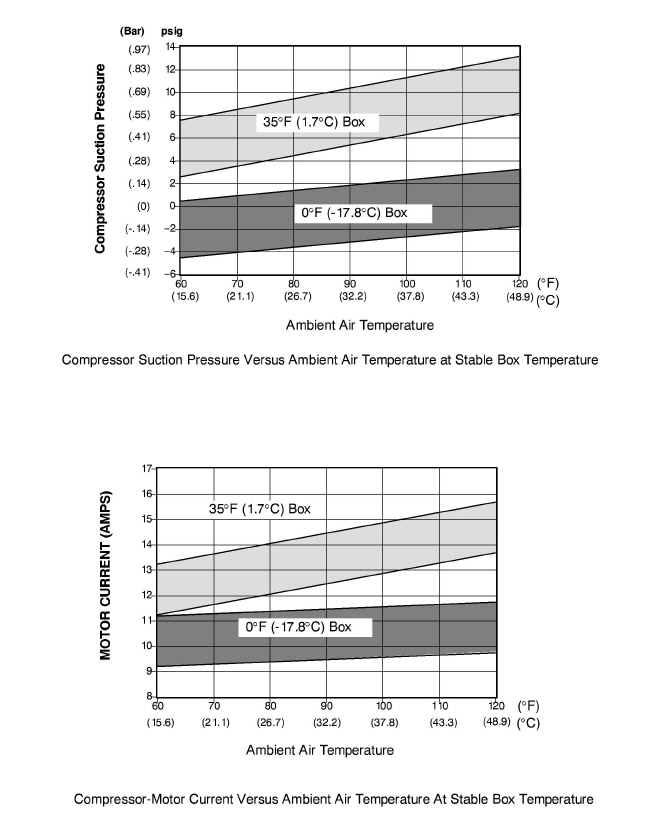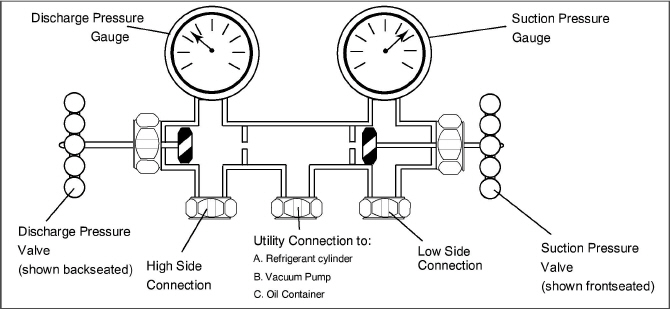
Section 7
Use a refrigerant recovery system whenever removing refrigerant. When working with refrigerants you must comply with all local government environmental laws. In the U.S.A., refer to EPA section 608.
EXPLOSION
HAZARD: Failure to follow this WARNING can result in death, serious personal
injury and / or property damage.
Never use air or gas mixtures containing oxygen (O2) for leak
testing or operating the product.
Charge Only With R−134a: Refrigerant must conform to AHRI Standard 700
specification.
Service procedures are provided in this section beginning with refrigeration system service, then refrigeration system component service, electrical system service, temperature recorder service and general service. Refer to the Table of Contents to locate specific topics.
The manifold gauge set (see Figure 7.1) is used to determine system operating pressure, add refrigerant charge, and to equalize or evacuate the system.

When the Suction Pressure Valve is frontseated (turned all the way in), the suction (low) pressure can be checked at the Suction Pressure Gauge.
When the Discharge Pressure Valve is frontseated, the discharge (high) pressure can be checked at the Discharge Pressure Gauge.
When both valves are backseated (all the way out), high pressure vapor will flow into the low side.
When the Suction Pressure Valve is open and the Discharge Pressure Valve is shut, the system can be charged through the Utility Connection. Oil can also be added to the system.
A R-134a manifold gauge/hose set with self-sealing hoses (see Figure 7.2) is required for service of the models covered within this manual. The manifold gauge/hose set is available from Carrier Transicold. (Carrier Transicold P/N 07-00294-00, which includes items 1 through 6, Figure 7.2).
If the manifold gauge/hose set is new or was exposed to the atmosphere, it will need to be evacuated to remove contaminants and air as follows:
1.Backseat (turn counterclockwise) both field service couplings (see Figure 7.2) and midseat both hand valves.
2.Connect the yellow hose to a vacuum pump and refrigerant 134a cylinder.
3.Evacuate to 10 inches of vacuum and then charge with R-134a to a slightly positive pressure of 0.1kg/cm2 (1.0 psig).
4.Frontseat both manifold gauge set valves and disconnect from cylinder. The gauge set is now ready for use
Figure 7.2 R-134a Manifold Gauge/Hose Set
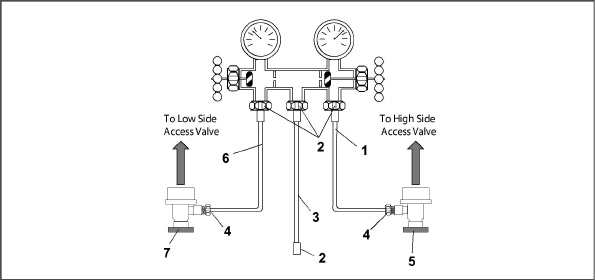
1.RED Refrigeration and/or Evacuation Hose (SAE J2196/R-134a)
3.YELLOW Refrigeration and/or Evacuation Hose (SAE J2196/R-134a)
4.Hose Fitting with O-ring (M14 x 1.5)
5.High Side Field Service Coupling (Red Knob)
6.BLUE Refrigeration and/or Evacuation Hose (SAE J2196/R-134a)
7.Low Side Field Service Coupling (Blue Knob)
- - - - -
Compressor suction, compressor discharge, and liquid line service valves (see Figure 7.3) are provided with a double seat and a gauge connection, which enables servicing of the compressor and refrigerant lines.
Turning the valve stem clockwise (all the way forward) will frontseat the valve to close off the suction, discharge or liquid line and open the gauge port to the compressor or low side. Turning the stem counterclockwise (all the way out) will backseat the valve to open the connections and close off the port.
With the valve stem midway between frontseat and backseat, both of the service valve connections are open to the access valve path.
For example, the valve stem is first fully backseated when connecting a manifold gauge to measure pressure. Then, the valve is opened 1/4 to 1/2−turn to measure the pressure.

5.Compressor or Filter Drier Inlet Connection
- - - - -
Connection of the manifold gauge/hose set (see Figure 7.4) is dependent on the component being serviced. If only the compressor is being serviced, the high side coupling is connected to the discharge service valve.
For service of the low side (after pump down), the high side coupling is connected to the liquid line service valve. The center hose connection is brought to the tool being used (vacuum, tank, etc.).
Connecting the manifold gauge set:
a.Remove service valve stem cap and make sure the valve is backseated.
b.Remove service port cap (See Figure 7.3).
c.Connect the high side field service coupling (see Figure 7.2) to the discharge or liquid line valve service valve port.
d.Turn the high side field service coupling knob (red) clockwise, which will open the high side of the system to the gauge set.
e.Connect the low side field service coupling to the suction service valve port.
f.Turn the low side field service coupling knob (blue) clockwise, which will open the low side of the system to the gauge set.
g.To read system pressures, slightly midseat the high side and suction service valves.
To prevent trapping liquid refrigerant in the manifold gauge set, be sure set is brought to suction pressure before disconnecting.
Removing the Manifold Gauge Set:
a.While the compressor is still ON, backseat the high side service valve.
b.Midseat both hand valves on the manifold gauge set and allow the pressure in the manifold gauge set to be drawn down to suction pressure. This returns any liquid that may be in the high side hose to the system.
c.Backseat the suction service valve. Backseat both field service couplings and frontseat both manifold set valves. Remove the couplings from the service ports.
d.Install both service valve stem caps and service port caps (finger-tight only).
To service the filter-drier, moisture-liquid indicator, expansion valve, suction modulation valve, quench valve, or evaporator coil, pump the refrigerant into the high side as follows:
a.Attach manifold gauge set to compressor service valves (refer to Section 7.2).
b.Start the unit and run in a cooling mode for 10 to 15 minutes. Frontseat the liquid line service valve. Place start-stop switch in the OFF position when the suction reaches a positive pressure of 0.1kg/cm2 (1.0psig).
c.Frontseat the suction service valve. The refrigerant will be trapped between the compressor suction service valve and the liquid line valve.
d.Before opening up any part of the system, a slight positive pressure should be indicated on the pressure gauge. If a vacuum is indicated, emit refrigerant by cracking the liquid line valve momentarily to build up a slight positive pressure.
e.When opening up the refrigerant system, certain parts may frost. Allow the part to warm to ambient temperature before dismantling. This avoids internal condensation, which puts moisture in the system.
f.After repairs have been made, be sure to perform a refrigerant leak check (refer to Section 7.5), and evacuate and dehydrate the low side (refer to Section 7.6).
g.Check refrigerant charge (refer to Section 7.7).
EXPLOSION HAZARD: Failure to
follow this WARNING can result in death, serious personal injury and /
or property damage.
Never use air or gas mixtures containing oxygen (O2) for leak
testing or operating the product.
Charge Only With R−134a: Refrigerant must conform to AHRI Standard 700
specification.
a.The recommended procedure for finding leaks in a system is with a R-134a electronic leak detector. Testing joints with soapsuds is satisfactory only for locating large leaks.
b.If the system is without refrigerant, charge the system with refrigerant 134a to build up pressure between 2.1 to 3.5kg/cm2 (30 to 50psig). Remove refrigerant cylinder and leak-check all connections.
Only refrigerant 134a should be used to pressurize the system. Any other gas or vapor will contaminate the system, which will require additional purging and evacuation of the system.
c.If required, remove refrigerant using a refrigerant recovery system and repair any leaks.
d.Evacuate and dehydrate the unit (refer to Section 7.6).
e.Charge unit per Section 7.7.
Moisture is the deadly enemy of refrigeration systems. The presence of moisture in a refrigeration system can have many undesirable effects. The most common are copper plating, acid sludge formation, “freezing-up” of metering devices by free water, and formation of acids, resulting in metal corrosion.
a.Evacuate and dehydrate only after pressure leak test (refer to Section 7.5).
b.Essential tools to properly evacuate and dehydrate any system include a vacuum pump (8m/hr = 5cfm volume displacement) and an electronic vacuum gauge. The pump is available from Carrier Transicold, P/N 07-00176-11. The micron gauge is P/N 07−00414−00.
c.If possible, keep the ambient temperature above 15.6°C (60°F) to speed evaporation of moisture. If the ambient temperature is lower than 15.6°C (60°F), ice might form before moisture removal is complete. Heat lamps or alternate sources of heat may be used to raise the system temperature.
d.Additional time may be saved during a complete system pump down by replacing the filter-drier with a section of copper tubing and the appropriate fittings. Installation of a new drier may be performed during the charging procedure.
Figure 7.4 Refrigeration System Service Connections
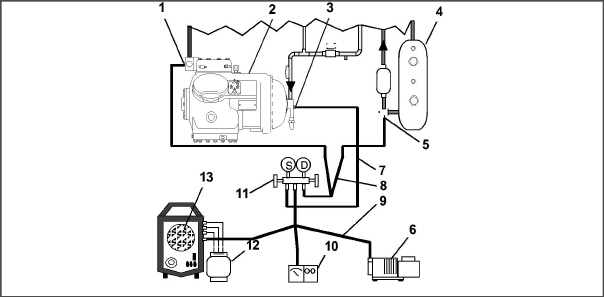
4.Receiver or Water Cooled Condenser
- - - - -
a.Remove all refrigerant using a refrigerant recovery system.
b.The recommended method to evacuate and dehydrate the system is to connect three evacuation hoses (see Figure 7.4) to the vacuum pump and refrigeration unit. Be sure the service hoses are suited for evacuation purposes.
c.Test the evacuation setup for leaks by backseating the unit service valves and drawing a deep vacuum with the vacuum pump and gauge valves open. Shut off the pump and check to see if the vacuum holds. Repair leaks if necessary.
d.Midseat the refrigerant system service valves.
e.Open the vacuum pump and electronic vacuum gauge valves, if they are not already open. Start the vacuum pump. Evacuate unit until the electronic vacuum gauge indicates 2000 microns. Close the electronic vacuum gauge and vacuum pump valves. Shut off the vacuum pump. Wait a few minutes to be sure the vacuum holds.
f.Break the vacuum with clean dry refrigerant 134a gas. Raise system pressure to approximately 0.2kg/cm2 (2psig), monitoring it with the compound gauge.
g.Remove refrigerant using a refrigerant recovery system.
h.Repeat steps e.and f. one time.
i.Remove the copper tubing and change the filter-drier. Evacuate unit to 500 microns. Close the electronic vacuum gauge and vacuum pump valves. Shut off the vacuum pump. Wait five minutes to see if vacuum holds. This procedure checks for residual moisture and/or leaks.
j.With a vacuum still in the unit, the refrigerant charge may be drawn into the system from a refrigerant container on weight scales. Continue to Section 7.7.
7.6.4Procedure - Partial System
a.If the refrigerant charge has been removed from the compressor for service, evacuate only the compressor by connecting the evacuation set-up at the compressor service valves. Follow evacuation procedures of the preceding paragraph except leave compressor service valves frontseated until evacuation is completed.
b.If refrigerant charge has been removed from the low side only, evacuate the low side by connecting the evacuation set-up at the compressor service valves and liquid service valve except leave the service valves frontseated until evacuation is completed.
c.Once evacuation has been completed and the pump has been isolated, fully backseat the service valves to isolate the service connections and then continue with checking and, if required, adding refrigerant in accordance with normal procedures.
EXPLOSION HAZARD: Failure to
follow this WARNING can result in death, serious personal injury and /
or property damage.
Never use air or gas mixtures containing
oxygen (O2) for leak testing or operating the product.
Charge Only With R−134a: Refrigerant
must conform to AHRI Standard 700 specification.
7.7.1Checking the Refrigerant Charge
To avoid damage to the earth’s ozone layer, use a refrigerant recovery system whenever removing refrigerant. When working with refrigerants you must comply with all local government environmental laws. In the U.S., refer to EPA section 608.
a.Connect the gauge manifold to the compressor discharge and suction service valves. For units operating on a water cooled condenser, change over to air-cooled operation.
b.Bring the container temperature to approximately 1.7°C (35°F) or -17.8°C (0°F). Set the controller set point to -25°C (-13°F) to ensure that the suction modulation valve is at maximum allowed open position.
c.Partially block the condenser coil inlet air. Increase the area blocked until compressor discharge pressure is raised to approximately 12kg/cm (175psig).
d.On units equipped with a receiver, the level should be between the glasses. On units equipped with a watercooled condenser, the level should be at the center of the glass. If the refrigerant level is not correct, continue with the following paragraphs to add or remove refrigerant as required.
7.7.2Adding Refrigerant to System (Full Charge)
a.Evacuate unit and leave in deep vacuum (refer to Section 7.6).
b.Place cylinder of R-134a on scale and connect charging line from cylinder to liquid line valve. Purge charging line at liquid line valve and then note weight of cylinder and refrigerant.
c.Open liquid valve on cylinder. Open liquid line valve half-way and allow the liquid refrigerant to flow into the unit until the correct weight of refrigerant (refer to Section 3.2) has been added as indicated by scales.
It may be necessary to finish charging unit through suction service valve in gas form, due to pressure rise in high side of the system (refer to Section 7.7.3).
d.Backseat manual liquid line valve (to close off gauge port). Close liquid valve on cylinder.
e.Start unit in cooling mode. Run approximately 10 minutes and check the refrigerant charge.
7.7.3Adding Refrigerant to System (Partial Charge)
a.Examine the unit refrigerant system for any evidence of leaks. Repair as necessary (refer to Section 7.5).
b.Maintain the conditions outlined in Section 7.7.1.
c.Fully backseat the suction service valve and remove the service port cap.
d.Connect charging line between suction service valve port and cylinder of refrigerant R-134a. Open VAPOR valve.
e.Partially frontseat (turn clockwise) the suction service valve and slowly add charge until the refrigerant appears at the proper level.
Make sure power to the unit is OFF and power plug disconnected before replacing the compressor.
NOTES
1.The compressor should not operate in a vacuum greater than 500mm/hg (20 inches/hg).
2.The service replacement compressor is sold without shutoff valves (but with valve pads), and without terminal box and cover. Customer should retain the original terminal box, cover, and high pressure switch for use on replacement compressor.
3.Check oil level in service replacement compressor (refer to Section 7.8.6).
4.A compressor terminal wiring kit must be ordered as a separate item when ordering replacement compressor. Appropriate installation instructions are included with kit.
5.Refer to Table 7–7 and Table 7–8 for applicable compressor wear limits and torque values.
6.Refer to Figure 7.37 for charts on compressor pressure, temperature and motor current curves.
7.8.1Removal and Replacement of Compressor
a.Remove the protective guard from lower section of the unit.
b.Pump down low side (refer to Section 7.4) or frontseat compressor service valves and remove refrigerant from compressor using a refrigerant recovery system.
c.Locate the compressor junction box. Tag and disconnect wiring from compressor terminals and remove compressor junction box.
d.Loosen service valve mounting bolts, break seal, and then remove bolts.
e.Remove compressor plate mounting bolts.
f.Remove compressor and mounting plate. Refer to Section 3.2 for weight of compressor.
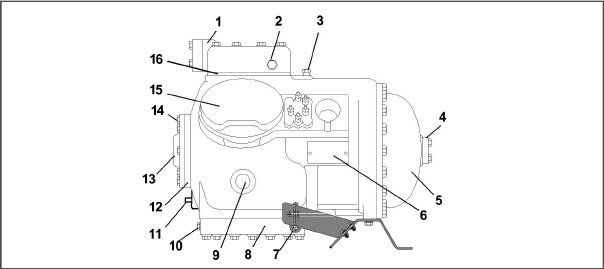
2.High Side Pressure Connection
3.Low Side Pressure Connection
- - - - -
g.Remove high pressure switch (HPS) from compressor and check operation of switch (refer to Section 7.9.1).
h.Remove compressor mounting bolts from mounting plate and install mounting plate on replacement compressor.
i.Install replacement compressor terminal wiring kit, following instructions included with kit.
j.Install high pressure switch on compressor.
k.Install compressor and mounting plate in unit.
l.Connect junction box(es) to compressor and connect all wiring per wiring diagram. Install junction box cover(s).
m.Install new gaskets on service valves.
n.Install mounting bolts in service valves and torque to 2.77 to 4.15mkg (20-30ft/lb).
o.Attach two hoses (with hand valves near vacuum pump) to the suction and discharge service valves. Dehydrate and evacuate compressor to 500 microns (75.9 cm Hg vacuum = 29.90 inches Hg vacuum). Turn off valves on both hoses to pump.
p.Fully backseat (open) both suction and discharge service valves.
q.Remove vacuum pump lines.
r.Start unit and check refrigerant charge (refer to Section 7.7).
s.Check moisture-liquid indicator for wetness. Change filter-drier if necessary (refer to Section 7.13).
t.Check compressor oil level per Section 7.8.6. Add oil if necessary.
Before disassembly of any external compressor component make sure to relieve possible internal pressure by loosening the bolts and tapping the component with a soft hammer to break the seal.
Removing the compressor motor press-fit stator in the field is not recommended. The rotor and stator are a matched pair and should not be separated.
When disassembling compressor, matchmark parts so they may be replaced in their same relative positions (see Figure 7.5). Refer to Table 7–7 and Table 7–8 for compressor wear limits and bolt torque values.
a.Place the compressor in a position where it will be convenient to drain the oil. Remove the oil fill plug (see Figure 7.5) to vent the crankcase. Loosen the drain plug in bottom plate and allow the oil to drain out slowly. Remove the plug slowly to relieve any crankcase pressure. Some units have a plug in the bottom center of the crankcase, which may be removed for draining the motor end more quickly.
Figure 7.6 Exploded View of Valve Plate

2.Discharge Valve Screw & Lockwasher
- - - - -
Figure 7.7 Bottom Plate Removed
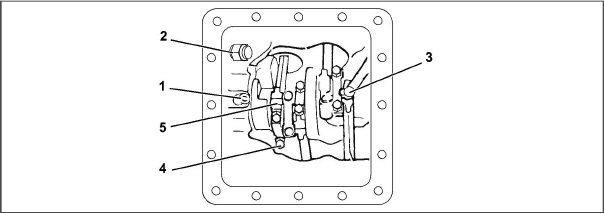
5.Connecting Rod and Cap Assembly
- - - - -
b.Loosen cylinder head cap screws. If the cylinder head is stuck, tap the center of the cylinder head with a wooden or lead mallet. Do not strike the side of the cylinder head. Be careful not to drop the head or damage the gasket sealing surface. Remove cylinder head bolts and gasket (see Figure 7.6).
c.Remove valve stops and valves. After they have been removed, free the valve plate from the cylinder deck by using the outside discharge valve hold-down cap screw as a jack screw through the tapped hole of the valve plate. Remove the valve plate gasket.
d.Turn the compressor on its side and remove the bottom plate oil suction screen and screen hold down plate. Inspect the screen for holes or an accumulation of dirt. The screen can be cleaned with a suitable solvent.
e.Match mark each connecting rod cap (see Figure 7.7) and connecting rod for correct reassembly. Remove the bolts and connecting rod caps. Push the piston rods up as far as they will go without having the piston rings extend above the cylinders.
The copper tube that connects to the oil suction strainer extends out the bottom with the bottom plate removed. Take precautions to avoid bending or breaking it while changing crankcase positions.
f.If necessary, remove the oil return check valve (see Figure 7.7). Inspect it for proper operation (flow in one direction only). Replace the assembly with a new unit if check valve operation is impaired.
g.To remove the oil pump (see Figure 7.8) remove eight cap screws, oil pump bearing head assembly, gasket, and thrust washer.
Figure 7.8 Oil Pump and Bearing Head
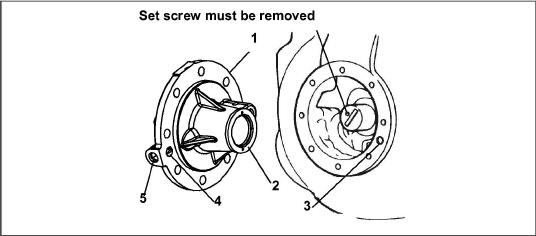
- - - - -
If the oil pump was not operating properly, the entire oil pump & bearing head assembly must be replaced. Individual parts are not available. If the pump requires inspection or cleaning, disassemble and reassemble by referring to Figure 7.9. Clean all parts and coat all moving parts with compressor oil before proceeding with reassembly.
Figure 7.9 Low Profile Oil Pump
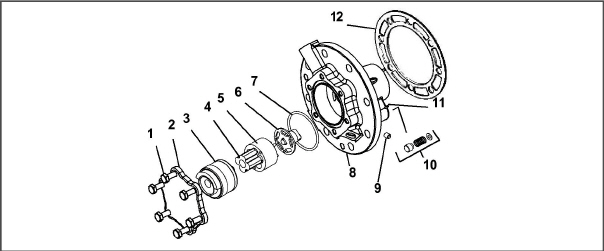
- - - - -
h.Be very careful not to damage the motor windings when removing the motor end cover (see Figure 7.10), as the cover fits over the winding coils. Loosen the cap screws, break the seal, and then remove all cap screws except one in the top of the cover. While holding the cover in place, remove the remaining cap screw. Do not allow the cover to drop from its own weight. To prevent striking the winding, remove the cover horizontally and in line with the motor axis.
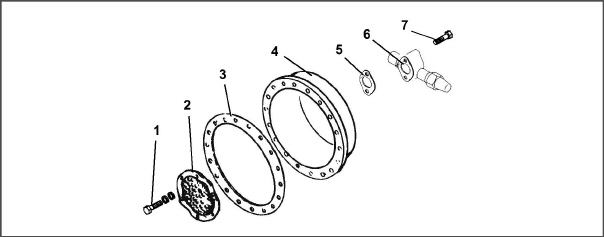
- - - - -
i.Remove the refrigerant suction strainer. If it is removed with ease, it may be cleaned with solvent and replaced. If the strainer is broken, corroded or clogged with dirt that is not easily removed, replace the strainer. Install new gaskets upon reassembly.
j.Block the compressor crankshaft so that it cannot turn. Use a screwdriver to bend back the tabs on the lockwasher, and remove the equalizer tube and lock screw assembly (see Figure 7.11). The slingers at the end of the tube draw vapor from the crankcase. Remove the rotor using a jack bolt. Insert a brass plug into the rotor hole to prevent damage to the end of the crankshaft.
k.If the piston rings extend beyond the cylinder tops, the pistons can be pulled through the bottom plate opening after the piston rings are compressed. A piston ring compressor will facilitate removal. Each piston pin is locked in place by lock rings, which are snapped into grooves in the piston wall (see Figure 7.12).
l.Since the stator cannot be replaced in the field, the terminal plate assembly need not be disturbed unless a leak exists and the plate assembly needs to be replaced. If no terminal plate repair is required, proceed with reassembly.
Figure 7.11 Equalizing Tube and Lock Screw Assembly
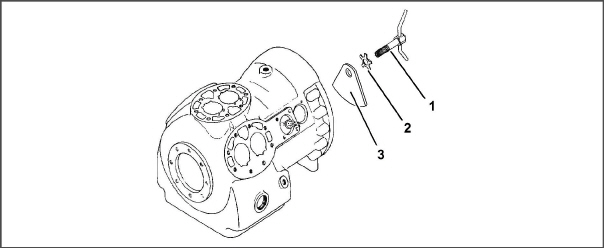
1.Equalizer Tube and Lock Screw Assembly
- - - - -
Figure 7.12 Crankshaft Assembly
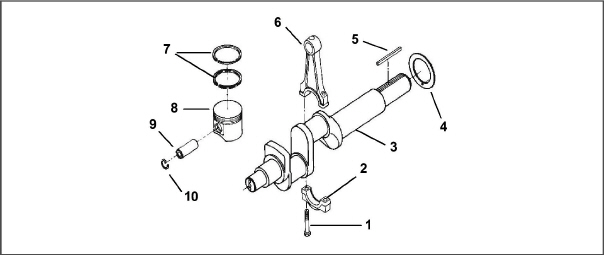
- - - - -
Clean all compressor parts, using a suitable solvent with proper precautions. Coat all moving parts with the proper compressor oil before assembly. Refer to Table 7–8 for applicable compressor torque values.
a. Suction and Discharge Valves
If the valve seats look damaged or worn, replace valve plate assembly. Always use new valves because it is difficult to reinstall used valves so that they will seat as before removal. Any valve wear will cause leakage.
Figure 7.13 Suction Valve and Positioning Rings
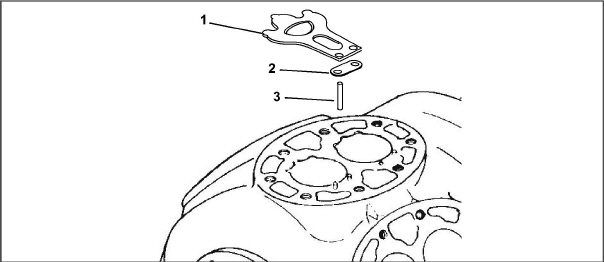
2.Suction Valve Positioning Spring
- - - - -
Suction valves are positioned by dowel pins (see Figure 7.13). Do not omit the suction valve positioning springs. Place the springs so that the ends bear against the cylinder deck (middle bowed away from cylinder deck). Use new gaskets when reinstalling valve plates and cylinder heads.
b. Compression Rings
The compression ring is chamfered on the inside circumference. This ring is installed with the chamfer toward the top. Stagger the ring end gaps so they are not aligned.

The gap between the ends of the piston rings can be checked with a feeler gauge by inserting the ring into the piston bore approximately one inch below the top of the bore. Square the ring in the bore by pushing it slightly with a piston. The maximum and minimum allowable ring gaps are 0.33 and 0.127mm (0.013 and 0.005 inch) respectively.
7.8.5Installing the Components
a.Push pistons from the inside of the crankcase through the cylinders, be careful not to break rings. Place rods so that the chamfered side is against radius of crankpins. Install the crankshaft and thrust washer through the pump end of the compressor. Ensure thrust washer is fitted on locating pin. Do not damage main bearings. Bring rods in position against crank bearings.
b.Install the pump end thrust washer on the two dowel pins located on the bearing head (see Figure 7.8).
Ensure that the thrust washer does not fall off dowel pins while installing oil pump.
The set screw on the crankshaft must be removed for this type of oil pump (see Figure 7.8).
c.Install bearing head assembly with a new gasket on the compressor crankshaft. Carefully push oil pump on by hand, ensuring the thrust washer remains on the dowel pins. The tang on the end of the drive engages the slot in the crankshaft, and the oil inlet port on the pump is aligned with the oil pickup tube in the crankcase. The pump should be mounted flush with the crankcase, and oriented with the oil pick up tube and oil inlet port, and aligned as shown in Figure 7.8.
d.Align gasket and install eight cap screws in mounting flange. Refer to Table 7–8 for torque values.
e.Install matching connecting rod caps Be sure rod is not bound and crankshaft will turn correctly as each set of rod bolts is torqued.
f.Be sure key fits properly when installing rotor on shaft. Screw on equalizer tube and lock screw assembly with lock washer and bend over tabs of lock washer. Assemble suction strainer to motor and cover, and bolt cover to crankcase. Assemble valve plates and gaskets. Assemble cylinder heads & gaskets. Turn shaft by hand to see that it moves freely.
g.Install the oil suction screen, the oil suction screen hold down plate, and the bottom plate.
Use only Carrier Transicold approved Polyol Ester Oil (POE) − Castrol-Icematic SW20 compressor oil with R-134a. Buy in quantities of one quart or smaller. When using this hygroscopic oil, immediately reseal. Do not leave container of oil open or contamination will occur.
a. Checking the Oil Level in the Compressor
1.Turn unit on and operate in cooling mode for at least 20 minutes.
2.Check the front oil sight glass on the compressor to ensure that no foaming of the oil is present after 20 minutes of operation. If the oil is foaming excessively after 20 minutes of operation, check the refrigerant system for flood-back of liquid refrigerant. Correct this situation before performing step 3.
3.Turn unit off to check the oil level. The correct oil level range should be between the bottom to one-eighth level of the sight glass. If the level is above one-eighth, oil must be removed from the compressor. To remove oil from the compressor, follow step d in this section. If the level is below the bottom of the sight glass, add oil to the compressor following step b below.
b. Adding Oil with Compressor in System
1.The recommended method is to add oil using an oil pump at the oil fill valve (see item 11, Figure 7.5).
2.In an emergency where an oil pump is not available, oil may be drawn into the compressor through the suction service valve.
Connect the suction connection of the gauge manifold to compressor suction service valve port and immerse the common connection of the gauge manifold in a container of refrigeration oil. Extreme care must be taken to ensure the manifold common connection remains immersed in oil at all times. Otherwise air and moisture will be drawn into compressor.
Crack the suction service valve and gauge valve to vent a small amount of refrigerant through the common connection and the oil to purge the lines of air. Close the gauge manifold valve.
With the unit running, frontseat the suction service valve and induce a vacuum in the compressor crankcase. SLOWLY crack the suction gauge manifold valve and oil will flow through the suction service valve into the compressor. Add oil as necessary.
c. Adding Oil to Service Replacement Compressor
Service replacement compressors are shipped without oil. If oil is present in crankcase, test the oil to ensure it is the correct oil and that moisture level is acceptable.
When adding oil to a service replacement compressor add three liters (6.3 pints) using an oil pump at the oil fill valve (see item 11, Figure 7.5). This quantity is recommended to allow for return of any oil that may be in the refrigerant system. Install compressor and check oil level after it is placed in operation (refer to Section 7.8.6).
d. Removing Oil from the Compressor
1.If the oil level is above one-eighth sight glass, excess oil must be removed from the compressor.
2.Close (frontseat) suction service valve and pump unit down to 1.2 to 1.3kg/cm (2 to 4psig). Frontseat discharge service valve and remove remaining refrigerant.
3.Loosen the oil drain plug on the bottom plate of the compressor and drain the proper amount of oil from the compressor to obtain the correct level.Backseat the suction and discharge service valves.
4.Repeat step a to ensure proper oil level.
7.9.1Checking High Pressure Switch
Do not use a nitrogen cylinder without a pressure regulator.
The high pressure switch is non-adjustable.
a.Remove switch as outlined in Section 7.9.2.
b.Connect ohmmeter or continuity light across switch terminals. Ohm meter will indicate no resistance or continuity light will be illuminated if the switch closed after relieving compressor pressure.
c.Connect hose to a cylinder of dry nitrogen, see Figure 7.15.
Figure 7.15 High Pressure Switch Testing

4.Pressure Gauge (0 to 36 kg/cm2 = 0 to 400 psig)
- - - - -
d.Set nitrogen pressure regulator at 26.4kg/cm2 (375psig) with bleed-off valve closed.
e.Close valve on cylinder and open bleed-off valve.
f.Open cylinder valve. Slowly close bleed-off valve to increase pressure on switch. The switch should open at a static pressure up to 25kg/cm2 (350 psig). If a light is used, light will go out. If an ohmmeter is used, the meter will indicate open circuit.
g.Slowly open bleed-off valve to decrease the pressure. The switch should close at 18kg/cm2 (250 psig).
7.9.2Replacing the High Pressure Switch
a.Turn unit start-stop switch OFF. Frontseat both suction and discharge service valves to isolate compressor. Remove the refrigerant from the compressor.
b.Disconnect wiring from defective switch. The high pressure switch is located on the center head and is removed by turning counterclockwise (see Figure 3.3).
c.Install a new high pressure switch after verifying switch settings (refer to Section 7.9.1).
d.Evacuate and dehydrate the compressor per Section 7.6.
The condenser consists of a series of parallel copper tubes expanded into copper fins. The condenser coil must be cleaned with fresh water or steam so the air flow is not restricted. To replace the coil, do the following:
Do not remove the condenser fan grille before turning power OFF and disconnecting the power plug.
a.Using a refrigerant reclaim system, remove the refrigerant charge.
b.Remove the condenser coil guard.
c.Unsolder lines and remove the line to the receiver or water-cooled condenser.
d.Remove coil mounting hardware and remove the coil.
e.Install replacement coil and solder connections.
f.Leak-check the coil connections per Section 7.5. Evacuate the unit per Section 7.6 then charge the unit with refrigerant per Section 7.7.
7.11Condenser Fan and Motor Assembly
Do not remove the condenser fan grille before turning power OFF and disconnecting the power plug.
The condenser fan rotates counter-clockwise (viewed from front of unit). The fan pulls air through the condenser coil, and discharges the air horizontally through the front of the unit. To replace motor assembly:
a.Open condenser fan screen guard.
b.Loosen two square head set screws on fan (thread sealer has been applied to set screws at installation).
c.Disconnect wiring from motor junction box.
Take necessary steps (place plywood over coil or use sling on motor) to prevent motor from falling into condenser coil.
d.Remove motor mounting hardware and replace the motor. It is recommended that new locknuts be used when replacing motor. Connect wiring per wiring diagram.
e.Install fan loosely on motor shaft (hub side in). DO NOT USE FORCE. If necessary, tap the hub only, not the hub nuts or bolts. Install venturi. Apply “Loctite H” to fan set screws. Adjust fan within venturi so that the outer edge of the fan projects 3.2 to 6.4mm (3/16” 1/16”) back from edge of the venturi. Spin fan by hand to check clearance.
f.Close and secure condenser fan screen guard.
g.Apply power to unit and check fan rotation. If fan motor rotates backward, reverse wire numbers 5 and 8.
7.12Water-Cooled Condenser Cleaning
The water-cooled condenser is of the shell and coil type with water circulating through the cupro-nickel coil. The refrigerant vapor is admitted to the shell side and is condensed on the outer surface of the coil.
Rust, scale, and slime on the water-cooling surfaces inside of the coil interfere with the transfer of heat, reduce system capacity, cause higher head pressures and increase the load on the system.
By checking the leaving water temperature and the actual condensing temperature, it can be determined if the condenser coil is becoming dirty. A larger than normal difference between leaving condensing water temperature and actual condensing temperature, coupled with a small difference in temperature of entering and leaving condensing water, is an indication of a dirty condensing coil.
To find the approximate condensing temperature, with the unit running in the cooling mode, install a gauge 0 to 36.2 kg/cm (0 to 500psig) on the compressor discharge service valve.
Example: Discharge pressure is 10.3kg/cm2 (146.4psig). Referring to Table 7–9 (R-134a pressure/ temperature chart), the 10.3kg/cm2 (146.4psig) value converts to 43C (110F).
If the water-cooled condenser is dirty, it may be cleaned and de-scaled by the following procedure:
a.Turn unit off and disconnect main power.
b.Disconnect water pressure switch tubing by loosening the two flare nuts. Install one-quarter inch flare cap on water-cooled condenser inlet tube (replaces tubing flare nut). De-scale tubing if necessary.
What You Will Need:
1.Oakite Aluminum Cleaner®164, available as a powder in 20kg (44lb) pails and 205kg (450lb) drums.
2.Oakite composition No. 32, available as a liquid in cases, each containing 3.785 liters (4 U.S. gallon) bottles and also in carboys of 52.6kg (116lbs) net.
3.Fresh clean water.
4.Acid proof pump and containers or bottles with rubber hose.
When Oakite compound No. 32 is being used for the first time, the local Oakite Technical Service representative should be called in for assistance in planning the procedure. They will advise the reader on how to do the work with a minimum dismantling of equipment, estimate the time and amount of compound required, preparation, how to control and conclude the de-scaling operation by rinsing and neutralizing equipment before putting it back into service.
Summary of Procedure:
1.Drain water from condenser tubing circuit.
2.Clean water tubes with Aluminum Cleaner® 164 to remove mud and slime.
3.Flush.
4.De-scale water tubes with Oakite No. 32.
5.Flush.
6.Neutralize.
7.Flush.
8.Put unit back in service under normal load and check head (discharge) pressure.
Detailed Procedure:
1.Drain and flush the water circuit of the condenser coil. If scale on the tube inner surfaces is accompanied by slime, a thorough cleaning is necessary before de-scaling process can be accomplished.
2.To remove slime or mud, use Oakite Aluminum Cleaner® 164. Mix 170 grams (6 ounces) per 3.785 liters (1 U.S. gallon) of water. Mix cleaner in one half the volume of water, while stirring, and then add remaining water. Warm this solution and circulate through the tubes until all slime and mud has been removed.
3.After cleaning, flush tubes thoroughly with fresh clean water.
4.Prepare a 15% by volume solution for de-scaling by diluting Oakite compound No. 32 with water. This is accomplished by slowly adding 0.47 liter (1 U.S. pint) of the acid (Oakite No. 32) to 2.8 liters (3 U.S. quarts) of water.
Oakite No. 32 is an acid. Be sure that the acid is slowly added to the water. DO NOT PUT WATER INTO THE ACID - This will cause spattering and excessive heat.
Wear rubber gloves and wash the solution from the skin immediately if accidental contact occurs. Do not allow the solution to splash onto concrete. PUT WATER INTO THE ACID - this will cause spattering and excessive heat.
5.Fill the tubes with this solution by filling from the bottom. See Figure 7.16.
Figure 7.16 Water-Cooled Condenser Cleaning, Forced Circulation
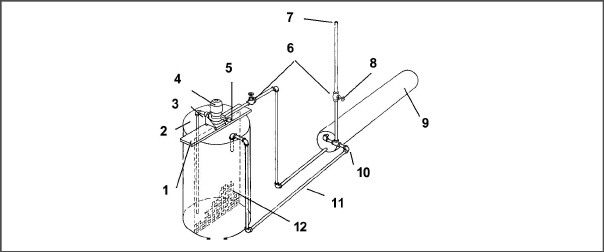
5.Priming Connection (Centrifugal pump50 gpm at 35’ head)
8.Close vent pipe valve when pump is running
10.Remove water regulating valve
- - - - -
It is important to provide a vent at the top for escaping gas.
6.Allow the Oakite No. 32 solution to soak in the tube coils for several hours, periodically pump-circulating it with an acid-proof pump.
An alternate method may be used whereby a pail (see Figure 7.17) filled with the solution and attached to the coils by a hose can serve the same purpose by filling and draining. The solution must contact the scale at every point for thorough de-scaling. Air pockets in the solution should be avoided by regularly opening the vent to release gas. Keep flames away from the vent gases.
7.The time required for de-scaling will vary, depending upon the extent of the deposits. One way to determine when de-scaling has been completed is to titrate the solution periodically, using titrating equipment provided free by the Oakite Technical Service representative. As scale is being dissolved, titrate readings will indicate that the Oakite No. 32 solution is losing strength. When the reading remains constant for a reasonable time, this is an indication that scale has been dissolved.
Figure 7.17 Water-Cooled Condenser Cleaning Gravity Circulation
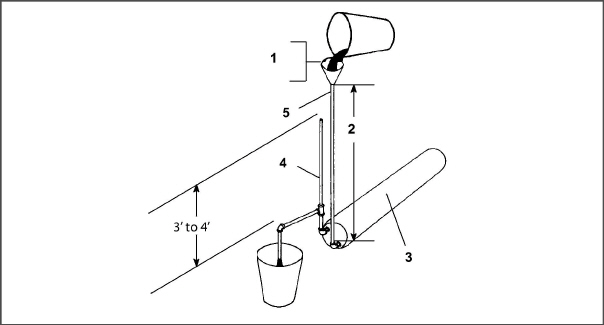
1.Fill condenser with cleaning solution. Do not add solution more rapidly than vent can exhaust gases caused by chemical action.
- - - - -
8.When de-scaling is complete, drain the solution and flush thoroughly with water.
If condenser cooling water is not being used as drinking water or is not re-circulated in a closed or tower system, neutralizing is not necessary.
9.Following the water flush, circulate a 56.7 gram (2 ounce) per 3.785 liter (1 U.S. gallon) solution of Oakite Aluminum Cleaner® 164 thru the tubes to neutralize. Drain this solution.
10.Flush the tubes thoroughly with fresh water.
11.Put the unit back in service and operate under normal load. Check the head pressure. If normal, a thorough de-scaling has been achieved.
What You Can Do For Further Help:
Contact the Engineering and Service Department of the OAKITE PRODUCTS CO., 675 Central Avenue, New Providence, NJ 07974 U.S.A. (or visit www.oakite.com) for the name and address of the service representative in your area.
On units equipped with a water-cooled condenser, if the sight glass appears to be flashing or bubbles are constantly moving through the sight glass when the suction modulation valve is fully open, the unit may have a low refrigerant charge or the filter-drier could be partially plugged.
a. To Check Filter-Drier:
1.Test for a restricted or plugged filter-drier by feeling the liquid line inlet and outlet connections of the drier cartridge. If the outlet feels cooler than the inlet, then the filter-drier should be changed.
2.Check the moisture-liquid indicator, if indicator shows a high level of moisture, the filter-drier should be replaced.
b. To Replace Filter-Drier:
1.Pump down the unit (refer to Section 7.4) and replace filter-drier.
2.Evacuate the low side in accordance with Section 7.6.
3.After unit is in operation, inspect for moisture in system and check charge.
7.14Thermostatic Expansion Valve
The thermostatic expansion valve (TXV) (see Figure 3.2) is an automatic device that maintains constant superheat of the refrigerant gas leaving the evaporator, regardless of suction pressure.
TXV functions are:
1.Automatic control of the refrigerant flow to match the evaporator load.
2.Prevention of liquid refrigerant entering compressor.
Unless the valve is defective, it seldom requires maintenance other than periodic inspection to ensure that the thermal bulb is tightly secured and properly insulated. See Figure 7.18.
TXV Bulb Clamp is soldered to the suction line.
Figure 7.18 Thermostatic Expansion Valve Bulb
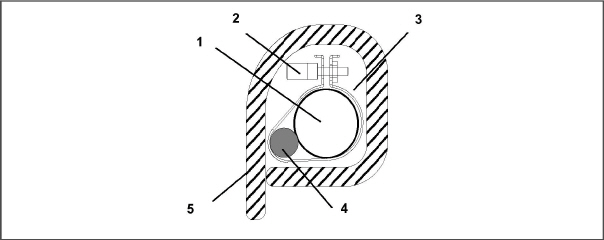
- - - - -
Proper superheat measurement should be completed at -18°C (0°F) container box temperature where possible.
a.Open the upper right (EFM#1) access panel (see Figure 3.1) to expose the expansion valve.
b.Attach a temperature sensor near the expansion valve bulb and insulate. Make sure the suction line is clean and that firm contact is made with the sensor.
c.Connect an accurate gauge to the service port directly upstream of the suction modulating valve.
d.Set the temperature set point to -18°C (0°F) and run unit until conditions stabilize.
e.The readings may cycle from a high to a low reading. Take readings of temperature and pressure every three to five minutes for a total of 5 or 6 readings.
f.From the temperature/pressure chart (Table 7–9), determine the saturation temperature corresponding to the evaporator outlet test pressures at the suction modulation valve.
g.Subtract the saturation temperatures in step f from the temperatures measured in step e. The difference is the superheat of the suction gas. Determine the average superheat. It should be 4.5 to 6.7°C (8 to 12°F).
NOTES
1.The TXV is a hermetic valve, it does not have adjustable superheat (See Figure 7.19).
2.All connections on the hermetic TXV are bi-metallic, copper on the inside and stainless on the outside.
3.All joints on the hermetic TXV (inlet, outlet and equalizer lines) are brazed.
4.Bi-metallic connections heat up very quickly.
Figure 7.19 Thermostatic Expansion Valve

1.Hermetic Thermostatic Expansion Valve
2.Non-adjustable Superheat Stem
6.Hermetic Expansion Valve Bulb
- - - - -
a. Removing the TXV:
1.Pump down the unit per Section 7.4.
2.If TXV replacement is to be performed from the front of the unit, open the upper right (EFM#1) access panel (see Figure 3.1) to remove evaporator fan motor.
3.Remove cushion clamp that secures the valve body to the bracket.
4.Unbraze the equalizer connection (1/4”), the outlet connection (5/8”), and then the inlet connection (3/8”). See Figure 7.21. Be careful to protect the insulation on the heaters and their wires.
5.Open the insulation flap. Flap is secured with Velcro (Item 3, Figure 7.20 ).
6.Loosen the thumb screw and slide the bulb, out by pulling it towards the front of the unit.
Figure 7.20 Hermetic Thermostatic Expansion Valve Bulb Location

1.Hermetic Expansion Valve Bulb
- - - - -
Figure 7.21 Hermetic Thermostatic Expansion Valve Brazing Procedure

b. Installing the TXV
1.Braze inlet connection to inlet line (see Figure 7.21 ).
2.Braze outlet connection to outlet line.
3.Braze the equalizer connection to the equalizer line.
4.Reinstall the cushion clamp.
5.Thread the thermal bulb through the opening above the evaporator coil (see Figure 3.2), and slide it under the strap and secure the thumb screw. Close the insulation flap. Reinstall bulb access panel.
6.Check superheat (refer to step Figure 7.14.1).
7.15Evaporator Coil & Heater Assembly
The evaporator section, including the evaporator coil, should be cleaned regularly. The preferred cleaning fluid is fresh water or steam. Another recommended cleaner is Oakite 202 or similar, following manufacturer’s instructions.
The two drain pan hoses are routed behind the condenser fan motor and compressor. The drain pan line(s) must be open to ensure adequate drainage.
7.15.1Evaporator Coil Replacement
a.Pump unit down. (Refer to Section 7.4).
b.With power OFF and power plug removed, remove the screws securing the panel covering the evaporator section (upper panel).
c.Disconnect the defrost heater wiring.
d.Disconnect the defrost temperature sensor (see Figure 3.2) from the coil.
e.Remove middle coil support.
f.Remove the mounting hardware from the coil.
g.Unsolder the two coil connections, one at the distributor and the other at the coil header.
h.After defective coil is removed from unit, remove defrost heaters and install on replacement coil.
i.Install coil assembly by reversing above steps.
j.Leak check connections per Section 7.5. Evacuate the unit per Section 7.6, and add refrigerant charge per Section 7.7.
7.15.2Evaporator Heater Replacement
The heaters are wired directly back to the contactor and if a heater failure occurs during a trip, the heater set containing that heater may be disconnected at the contactor.
The next Pre-trip (P1) will detect that a heater set has been disconnected and indicate that the failed heater should be replaced. To remove a heater, do the following:
a.Before servicing unit, make sure the circuit breakers (CB-1 and CB-2) and start-stop switch (ST) are in the OFF position, and the power plug is disconnected.
b.Remove the upper back panel.
c.Determine which heater(s) need replacing by checking resistance of each heater set. Refer to Section 3.3 for heater resistance values. Once the set containing the failed heater is determined, cut the splice connection and retest to determine the actual failed heater(s).
d.Remove hold-down clamp securing heater(s) to coil.
e.Lift the bent end of the heater (with the opposite end down and away from coil). Move heater to the side enough to clear the heater end support and remove.
7.16Evaporator Fan and Motor Assembly
The evaporator fans circulate air throughout the container by pulling air in the top of the unit. The air is forced through the evaporator coil where it is either heated or cooled and then discharged out the bottom of the refrigeration unit into the container. The fan motor bearings are factory lubricated and do not require additional grease.
7.16.1Replacing the Evaporator Fan Assembly
Always turn OFF the unit circuit breakers (CB-1 & CB-2) and disconnect main power supply before working on moving parts.
a.Remove access panel (see Figure 3.2) by removing mounting bolts and TIR locking device. Reach inside of unit and remove the Ty-Rap securing the wire harness loop. Disconnect the connector by twisting to unlock and pulling to separate.
b.Loosen four 1/4-20 clamp bolts that are located on the underside of the fan deck at the sides of the fan assembly. Slide the loosened clamps back from the fan assembly.
c.Slide the fan assembly out from the unit and place on a sturdy work surface.
7.16.2Disassemble the Evaporator Fan Assembly
a.Attach a spanner wrench to the two 1/4-20 holes located in the fan hub. Loosen the 5/8-18 shaft nut by holding the spanner wrench stationary and turning the 5/8-18 nut counter-clockwise (see Figure 7.22).
b.Remove the spanner wrench. Use a universal wheel puller and remove the fan from the shaft. Remove the washers and key.
c.Remove the four 1/4-20 x 3/4 long bolts that are located under the fan that support the motor and stator housing. Remove the motor and plastic spacer.
7.16.3Assemble the Evaporator Fan Assembly
a.Assemble the motor and plastic spacer onto the stator.
When removing the black nylon evaporator fan blade, care must be taken to assure that the blade is not damaged. In the past, it was a common practice to insert a screwdriver between the fan blades to keep it from turning. This practice can no longer be used, as the blade is made up of a material that will be damaged. It is recommended that an impact wrench be used when removing the blade. Do not use the impact wrench when reinstalling, as galling of the stainless steel shaft can occur.
b.Apply Loctite to the 1/4-20 x 3/4 long bolts and torque to 0.81 mkg (70 inch-pounds).
c.Place one 5/8 flat washer on the shoulder of the fan motor shaft. Insert the key in the keyway and lubricate the fan motor shaft and threads with a graphite-oil solution (such as Never-seez).
d.Install the fan onto the motor shaft. Place one 5/8 flat washer with a 5/8-18 locknut onto the motor shaft and torque to 40 foot-pounds.
Figure 7.22 Evaporator Fan Assembly
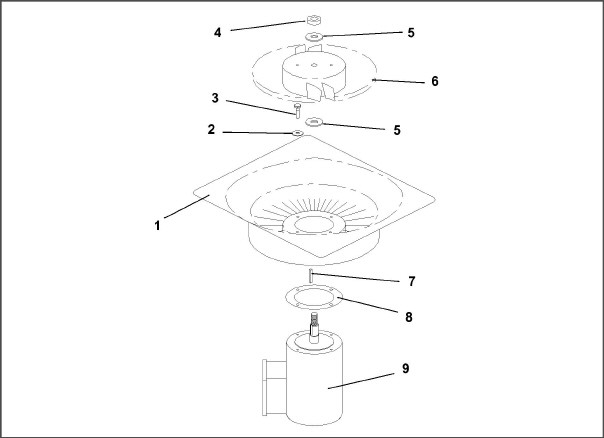
- - - - -
e.Install the evaporator fan assembly in reverse order of removal. Torque the four 1/4-20 clamp bolts to 0.81 mkg (70 inch-pounds). Apply power momentarily to check for proper fan rotation (refer to Section 3.3).If fan spins backward, then motor wiring or motor is defective.
f.Replace access the panel making sure that the panel does not leak. Make sure that the TIR locking device is lockwired.
7.17Evaporator Fan Motor Capacitor
For units equipped with single permanent-split capacitor fan motors.
7.17.1When To Check For A Defective Capacitor
a.If the fan motor will not change speed. For example: in perishable mode, the motors should run in high speed, in economy perishable mode fans should switch speeds and in frozen mode, the fans should run in low speed.
Evaporator fan motors always start in high speed.
b.Fan motor running in wrong direction (after checking for correct wiring application).
c.Motor will not start and IP-EMs are not open.
Make sure power to the unit is OFF and power plug disconnected before servicing capacitor(s)
With power OFF discharge the capacitor before disconnecting the circuit wiring.
Capacitors must be discharged properly before testing. To discharge the capacitor, first turn the unit power OFF and disconnect the unit power plug. Then place a 20,000 ohm, 2 watt resistor across the terminals of the capacitor for approximately 30 seconds.
The capacitors are located on the motor and may be removed by two methods:
1.If container is empty, open upper rear panel of the unit.
2.If container is full, turn the unit power OFF and disconnect power plug. Remove the evaporator fan motor access panel (see Figure 3.1). For removal of the evaporator fan assembly, refer to Section 7.16.
If the capacitor is suspected of malfunction, you may
choose to simply replace it. Direct replacement requires a capacitor of the same value. Two methods for checking capacitor function are:
1. Volt-ohmmeter set on RX 10,000 ohms.
Connect ohmmeter leads across the capacitor terminals and observe the meter needle. If the capacitor is good, the needle will make a rapid swing toward zero resistance and then gradually swing back toward a very high resistance reading.
If the capacitor has failed open, the ohmmeter needle will not move when the meter probes touch the terminals. If the capacitor is shorted, the needle will swing to zero resistance position and stay there.
2. Capacitor analyzer:
The function of the analyzer is to read the microfarad value of a capacitor and to detect insulation breakdown under load conditions. The important advantages of an analyzer are its ability to locate capacitors that have either failed to hold their microfarad ratings or those that are breaking down internally during operation. It is also useful in identifying capacitors when their microfarad rating marks have become unreadable.
7.18Evaporator Section Cleaning
Containers and Container units that are exposed to certain fumigants may develop visible surface corrosion. This corrosion will show up as a white powder found on the inside of the container and on the reefer unit evaporator stator and fan deck.
Analyses by Carrier Transicold environmental specialists have identified the white powder as consisting predominantly of aluminum oxide. Aluminum oxide is a coarse crystalline deposit most likely the result of surface corrosion on the aluminum parts within the container. If left untreated over time, it may build up in thickness and eventually flake as a lightweight white powder.
The surface corrosion of aluminum is brought about by exposure to chemicals such as sulfur dioxide and possibly other fumigants that are commonly used for fumigation and protection of some perishable cargo such as grapes, for example. Fumigation is the process by which a chemical is released into an enclosed area to eliminate infestations of insects, termites, rodents, weeds and soil−born disease.
Typically any aluminum oxide that becomes detached from evaporator fan stators will be blown into the wet evaporator coil where it will be caught and then flushed out of the unit during routine defrost cycles.
However, it is still highly recommended that after carrying cargo subject to fumigation procedures, that the inside of the unit be thoroughly cleansed prior to reuse.
Carrier Transicold has identified a fully biodegradable and environmentally safe alkaline cleaning agent (Tri−Pow’r® HD) for the unit. This will assist in helping to remove the corrosive fumigation chemicals and dislodging of the corrosive elements.
This cleaner is available from the Carrier Transicold Performance Parts Group (PPG) and can be ordered through any of the PPG locations; Part Number NU4371−88.
As a general safety precaution, before using this product, refer to and retain the Material Safety Data (MSDS) sheet. This document can be found at: www.nucalgon.com/products/coil_cleaners_tripower.htm
Prior to Cleaning:
•Always wear goggles, gloves and work boots.
•Avoid contact with skin and clothing, and avoid breathing mists.
•When mixing, add water to the sprayer first, then the cleaner.
•ALWAYS provide for proper ventilation when cleaning indoor evaporator coils (rear doors must be open).
•Be aware of surroundings − food, plants, etc., and the potential for human exposure.
•Always read directions and follow recommended dilution ratios. More is not always better. Using non−diluted cleaner is not recommended.
Cleaning Procedure:
a.Remove the upper evaporator access panel inside of the unit.
b.Spray the surface with water before applying the cleaning solution. This helps the cleaner work better.
c.Liberally apply the prepared cleaner solution (5 parts water and 1 part cleaner).
d.Allow the cleaner to soak in for 5 to 7 minutes.
e.Assess area for rinsing. Follow all local regulations regarding disposal of waste water.
f.Thoroughly rinse the cleaner and surrounding area, floor, etc. When rinsing where heavy foaming solution is present, it is very important to take the time to thoroughly rinse the equipment and surroundings.
g.Always rinse the empty coil cleaner bottle, cap tightly and dispose of properly.
On start up of the unit, the SMV will reset to a known open position. This is accomplished by assuming the valve was fully open, driving it fully closed, resetting the percentage open to zero, then opening to a known 21% staging position.
Figure 7.23 Suction Modulation Valve (SMV)
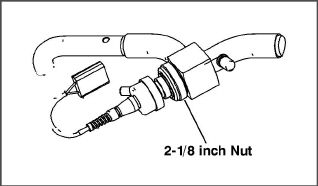
a.Check unit for abnormal operation.
b.Check charge. If refrigerant is low repair as required and again check operation.
c.If sufficient capacity cannot be maintained or unit is tripping excessively on high pressure switch (HPS) in high ambients, check coils and clean if required.
d.If capacity or control cannot be maintained, turn unit OFF, then back ON. This will reset the SMV in the event the controller lost communication with the valve, and may correct the problem.
Carefully listen to the valve. During reset, the valve will make a ratcheting noise that may be heard or felt as it is attempting to close. If this can be heard or felt, it indicates that the controller and drive module are attempting to close the valve, and may serve as a quick indication that the drive module is in working order.
e.During the first few minutes of unit operation, compressor reliability enhancement logic (CREL) may be in effect. This places the valve at a 21% staging position and is sufficient to drive the temperature of the supply probe down several degrees during this interval.
f.After the CREL time-out has been met, the valve will start responding to the control logic and open or close relative to the demand. Scrutinize the unit operation for a few minutes. While in pulldown, the unit will open the SMV to a maximum discharge pressure of 325 psig in high ambient conditions, or as much as the current setting and control logic will allow. The current level should be high. A lower discharge pressure will be seen in lower ambient temperatures. Once the unit has reached set point, the SMV will go into control mode. Both the discharge/suction pressures, and current draw will go significantly lower. Once below set point, the suction pressure should go into a vacuum within several minutes. Should the operation differ as mentioned, the SMV, controller, or wiring, may be faulty.
g.Check for correct wire location at the stepper motor plug and the environmental connector (EC). Make sure that the wires terminate in accordance with the wire markings (addresses).
h.Attach a manifold gauge set (refer to Section 7.2). If the unit is operating in the perishable mode, proceed to step i. If the unit is operating in the frozen mode, proceed to step j.
i.Perishable operation: If the operation of the unit is in question, place the set point to approximately 6°C (11°F) less than the current box temperature, so the unit goes into pulldown. Run the unit for approximately one minute. Record readings on gauges and current draw. The current draw and pressures should go up. Place set point 0.5°C (0.9°F) above current box temperature to fully modulate valve, and run for approximately one minute.
The unit may shut off for a short time. Wait until the unit self starts and sufficient time has elapsed to cause the valve to fully modulate.
Record new gauge readings and current draw. The suction pressure should go into a vacuum and the current draw should have gone down. If little or no change to the suction pressure or current draw occurs, this is an indication of a malfunctioning SMV.
j.Frozen operation: In frozen mode the valve tends to stay open as much as possible. Again, this is dependent upon current limit setting and control logic. Turn the unit OFF and ON, as in the perishable mode, and watch the gauges. The valve will run at 21% open if CREL logic is active, and will open to maximum allowable after this. Depending on ambient conditions, there should be an increase in suction pressure and current draw as the valve opens. However, at times, this may be difficult to fully determine.
k.If the unit still does not operate properly, stop unit and proceed to the following step to check out the SMV system.
Cd41 is a configurable function code that allows manual operation of the SMV valve for troubleshooting. Test sequences are provided in Table 7–1.
PCnt (% Setting − SMV Capacity Modulation) allows opening of the SMV to various percentages.
The Override Timer (tIM) selection is provided to enter a time period of up to five minutes, during which the override is active. If the timer is active, the valve override selection will take place immediately. If the timer is not active, changes will not take place for a few seconds after the timer is started. When the timer times out, override function is automatically terminated and the valve returns to normal machinery control. To operate the override, do the following:
a.Press the CODE SELECT key then press an ARROW key until Cd41 is displayed in the left window. The right window will display a controller communications code.
b.Press the ENTER key. The left display will show a test name alternating with the test setting or time remaining. Use an ARROW key to scroll to the desired test. Press the ENTER key and SELCt will appear in the left display.
c.Use an ARROW key to scroll to the desired setting, and then press the ENTER key. Selections are provided in the following table.
d.If the timer is not operating, follow the above procedure to display the timer. Use an ARROW key to scroll to the desired time interval and press ENTER to start the timer.
e.The above described sequence may be repeated during the timer cycle to change to another override.
7.20.1Checking the Stepper Valve
a. Checking with ohmmeter
Stop the unit, disconnect the 4-pin connector to the stepper SMV. With a reliable digital ohmmeter, check the winding resistance. In normal ambient, the valve should have 72 to 84 ohms measured on the red/green (a-b terminals) and on the white/black (c-d terminals) leads. If an infinite or zero reading occurs, check connections and replace the motor. If near normal or normal reading occurs, proceed to step 7.20.2 to check out the controller.
b. Checking with SMA-12 portable stepper drive tester
The SMA-12 portable stepper drive tester (Carrier Transicold P/N 07-00375-00) is a battery−operated stepper drive that will open and close the SMV, allowing a more thorough check of the motor.
1.Stop the unit, disconnect the 4-pin connector from the stepper module to the valve (see Figure 7.23) and attach the SMA-12 stepper drive to the connector going to the valve.
2.Set the SMA-12 pulse per second (PPS) to one PPS and either open or close valve. Each LED should light sequentially until all four are lit. Any LED failing to light indicates an open on that leg, which indicates a poor connection or an open coil. Repair or replace as required to achieve proper operation.
3.Restart unit, set the step rate to 200PPS on SMA-12 for the valve, and close stepper valve while watching the suction gauge. Within one minute the suction pressure will go into a vacuum. This is an indication that the valve is moving.
4.If no change in suction pressure is detected, check for resistance (refer to step 7.20.1), and check connections for proper continuity and retest. If the valve is functioning, and all connections and motor resistance are good, check the drive module (refer to step 7.20.2).
5.If the valve is determined to be faulty after completing the above steps, perform a low side pump down. Remove valve powerhead assembly, and replace with a NEW valve powerhead assembly, torque nut to 35ft-lb, evacuate low side, and open all service valves.
DO NOT disassemble piston from NEW suction modulating valve powerhead assembly. Doing so may result in damage to piston.
a.Turn unit OFF.
b.With voltmeter set to read 20 volts DC, attach the positive lead to MC1 of the 4-pin connector and the negative lead to the TP9. Turn ON unit and watch the volt meter. After a short delay, the reading should remain unchanged at 0 volts. If 5VDC, make sure the jumper wire from MC1 to MC8 is in place; if not, install and retest.
7.20.3SMV Emergency Repair Procedure
In the event of an SMV failure, and replacement components are not readily available, the system can be bypassed by removing the SMV valve piston. To remove the piston, do the following:
a.Perform a low side pump down (refer to Section 7.4).
b.Remove SMV powerhead by loosening the 2-1/8 inch diameter nut (see Figure 7.23) to relieve any pressure and then sliding the powerhead out.
c.Remove the piston by loosening the Allen screw and removing the piston and screw.
d.Install the powerhead assembly (without the piston) and torque to 35 to 40ft-lbs.
e.Open all valves.
f.Start the unit.
g.Adjust the suction service valve so that the approximate temperature OR current limit is maintained. For perishable loads, it is recommended that the adjustment be made so that the available capacity is slightly larger than the load. The unit will cycle OFF and ON.
h.Once repair parts become available, repair as required.
The discharge pressure regulating valve (DPRV) is designed to maintain a minimal level of discharge pressure within the compressor. Refer to Section 3.2 for valve setting.
The following procedure can be used to perform a functional check:
a.Install a high pressure gauge at the discharge service valve.
b.Install another high pressure gauge at the liquid line service valve.
c.Run unit with -18°C (0°F) set point.
d.After five minutes, read both gauges and subtract the liquid line pressure from the discharge pressure. This is the actual differential pressure.
e.Using the ambient temperature and the chart below, determine the replacement differential pressure.
Figure 7.24 DPRV Replacement Value Chart
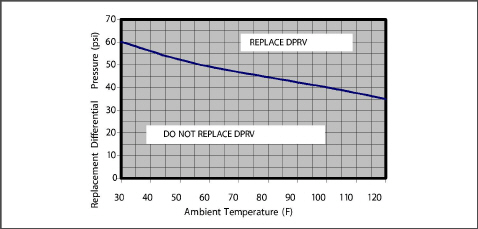
1.This test should not be run below -1.1°C (30°F) or above 49°C (120°F). If the actual differential pressure is close to the replacement differential pressure, it is recommended that the readings be taken several times at two minutes intervals.
2.If valve cap is found to be leaking it may be replaced using cap & O-ring (Carrier P/N 40-50024-00).
If the unit does not start, check the following:
a.Make sure the 460VAC (yellow) power cable is plugged into the receptacle (item 3, Figure 5.1) and locked in place.
b.Make sure circuit breakers CB-1 and CB-2 are in the “ON” position. If the circuit breakers do not hold in, check voltage supply.
c.There is no internal protector for this transformer design; therefore, no checking of the internal protector is required.
d.Using a voltmeter and with the primary supply circuit ON, check the primary (input) voltage (460VAC). Next, check the secondary (output) voltage (230VAC). The transformer is defective if output voltage is not available.
Do not remove wire harnesses from controller unless you are grounded to the unit frame with a static safe wrist strap.
Unplug all controller connectors before performing arc welding on any part of the container.
The guidelines and cautions provided herein should be followed when handling the Controller/DataCORDER module. These precautions and procedures should be implemented when replacing the module, when doing any arc welding on the unit, or when service to the refrigeration unit requires handling and removal of the controller.
a.Obtain a grounding wrist strap (Carrier Transicold P/N 07-00304-00) and a static dissipation mat (Carrier Transicold P/N 07-00304-00). The wrist strap, when properly grounded, will dissipate any potential electrostatic buildup on the body. The dissipation mat will provide a static-free work surface on which to place and/or service the controller.
b.Disconnect and secure power to the unit.
c.Place strap on wrist and attach the ground end to any exposed unpainted metal area on the refrigeration unit frame (bolts, screws, etc.).
d.Carefully remove the controller, refer to Section 7.23.4. Do not touch any of the electrical connections if possible. Place the module on the static mat.
e.The strap should be worn during any service work on the controller, even when it is placed on the mat.
7.23.2Controller Troubleshooting
A group of test points (TP) (see Figure 7.25) are provided on the controller for troubleshooting electrical circuits (see schematic diagram, Section 8). A description of the test points follows:
Use a digital voltmeter to measure AC voltage between TPs and ground (TP9), except for TP8.
TP 1 − NA
TP 2 − This test point enables the user to check if the internal protector for the compressor motor (IP-CP) or high pressure switch is open.
TP 3 − This test point enables the user to check if the water pressure switch (WP) contact is open or closed.
TP 4 − This test point enables the user to check if the internal protector for the condenser fan motor (IP-CM) is open or closed.
TP 5 − This test point enables the user to check if the internal protectors for the evaporator fan motors (IP-EM1 or IP-EM2) are open or closed.
TP 6 − This test point enables the user to check if the controller water tank heater relay (TQ) is open or closed.
TP 7 − This test point is not used in this application.
TP 8 − This test point is not applicable to the units covered herein.
TP 9 − This test point is the chassis (unit frame) ground connection.
TP 10 − This test point enables the user to check if the heat termination thermostat (HTT) contact is open or closed.
Figure 7.25 Controller Section of the Control Box
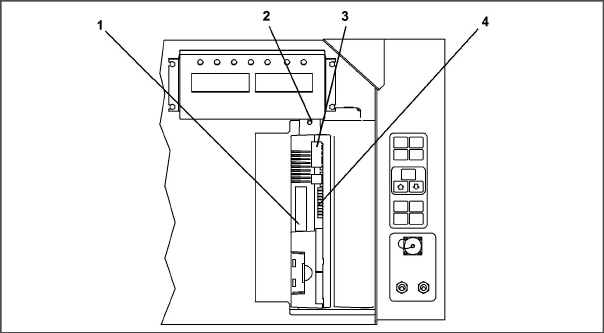
1.Controller Software Programming Port
- - - - -
7.23.3Controller Programming Procedure
To load new software into the module, the programming card (PCMIA) is inserted into the programming/ software port.
The unit must be OFF whenever a programming card is inserted or removed from the controller programming port.
Loading operational software:
1.Turn unit OFF via start-stop switch (ST).
2.Insert software/programming card containing the following (example) files into the programming/software port (see Figure 7.25):
menuDDMM.ml3 − This file allows the user to select a file/program to upload into the controller.
cfYYMMDD.ml3 − Multi-configuration file.
3.Turn unit ON via start-stop switch (ST).
4.The display module will display the message ruN COnFG. If a defective card is being used, the display will blink the message “bAd CArd.” Turn start-stop switch OFF and remove the card.
5.Press the UP or DOWN arrow key until display reads, LOAd 51XX for Recip.
6.Press the ENTER key on the keypad. The display will alternate to between PrESS EntR and rEV XXXX.
7.Press the ENTER key on the keypad.
8.The display will show the message “Pro SoFt”. This message will last for up to one minute.
9.Press the ENTER key on the keypad.
10.The display module will go blank briefly, then read “Pro donE” when the software is loaded. If a problem occurs while loading the software, the display will blink the message “Pro FAIL” or “bad 12V.” Turn start-stop switch OFF and remove the card.
11.Turn unit OFF via start-stop switch (ST).
12.Remove the programming card from the programming/ software port and return the unit to normal operation by placing the start-stop switch in the ON position.
13.Turn power on and wait 15 seconds. The status LED will flash quickly and there will be no display. The controller is loading the new software into memory. This takes about 15 seconds.
When complete the controller will reset and power up normally.
14.Wait for default display − setpoint on the left and control temperature on the right.
15.Confirm software is correct using keypad code select 18 to view Cd18 XXXX.
16.Turn power off. Operational software is loaded.
Loading configuration software:
1.Turn unit OFF using start-stop switch (ST).
2.Insert software/programming PCMCIA card containing the following (example) files into the programming/ software port (see Figure 7.25):
menuDDMM.ml3 − This file allows the user to select the file/program to upload into the controller.
cfYYMMDD.ml3 − Multi-configuration file.
recp54XX.ml3 − Controller software program for recip units.
3.Turn unit ON using start-stop switch (ST).
4.The display module will display the message ruN COnFG. If a defective card is being used, the display will blink the message “bAd CArd.” Turn start-stop switch OFF and remove the card.
5.Press the ENTER key on the keypad.
6.The display module will go blank briefly and then display “541 00.” Based on the operational software installed.
7.Press the UP or DOWN ARROW key to scroll through the list to obtain the proper model dash number. (If a defective card is being used, the display will blink the message “bAd CArd.” Turn start-stop switch OFF and remove the card.)
8.Press the ENTER key on the keypad.
9.When the software loading has successfully completed, the display will show the message “EEPrM donE.” (If a problem occurs while loading the software, the display will blink the message “Pro FAIL” or “bad 12V.” Turn start-stop switch OFF and remove the card.)
10.Turn unit OFF using start-stop switch (ST).
11.Remove the programming card from the programming/ software port and return the unit to normal operation by placing the start-stop switch in the ON position.
12.Confirm correct model configuration using the keypad to choose code select 20 (CD20). The model displayed should match the unit serial number plate.
7.23.4Removing and Installing the Controller
a. Removal:
1.Disconnect all front wire harness connectors and move wiring out of way.
2.The lower controller mounting is slotted. Loosen the top mounting screw (see Figure 7.25) and lift up and out.
3.Disconnect the two back connectors (EC) and remove module.
4.When removing the replacement controller from its packaging, note how it is packaged. When returning the old controller for service, place it in the packaging in the same manner as the replacement. The packaging has been designed to protect the controller from both physical and electrostatic discharge damage during storage and transit.
b. Installation:
Install the module by reversing the removal steps.
Torque values for mounting screws (item 2, see Figure 7.25) are 0.23mkg (20 inch-pounds). Torque value for the connectors is 0.12mkg (10 inch-pounds).
Standard Battery Location (Standard Cells):
a.Turn unit power OFF and disconnect power supply.
b.Slide bracket out and remove old batteries. (See Figure 4.4, Item 8.)
c.Install new batteries and slide bracket into control box slot.
Use care when cutting wire ties to avoid nicking or cutting wires.
Standard Battery Location (Rechargeable Cells):
a.Turn unit power OFF and disconnect power supply.
b.Disconnect battery wire connector from control box.
c.Slide out and remove old battery and bracket. (See Figure 4.4, Item 8.)
d.Slide new battery pack and bracket into the control box slot.
e.Reconnect battery wire connector to control box and replace wire ties that were removed.
Secure Battery Option (Rechargeable Cells Only):
a.Turn unit power OFF and disconnect power supply.
b.Open control box door and remove both the high voltage shield and clear plastic rain shield (if installed).
c.Disconnect the battery wires from the “KA” plug positions 14, 13, 11.
d.Using Driver Bit, Carrier Transicold part number 07−00418−00, remove the 4 screws securing the display module to the control box. Disconnect the ribbon cable and set the display module aside.
The battery wires must face toward the right.
e.Remove the old battery from the bracket and clean bracket surface. Remove the protective backing from the new battery and assemble to the bracket. Secure battery by inserting the wire tie from the back of the bracket around the battery, and back through the bracket.
f.Reconnect the ribbon cable to display and re−install the display.
g.Route the battery wires from the battery along the display harness and connect the red battery wire and one end of the red jumper to “KA14,” the other end of the red jumper wire to “KA11,” and the black wire to “KA13.”
h.Replace wire ties that were removed.
7.24Temperature Sensor Service
Service procedures for service of the return recorder, return temperature, supply recorder, supply temperature, ambient, defrost temperature, compressor discharge and compressor suction temperature sensors are provided in the following sub paragraphs.
7.24.1Sensor Checkout Procedure
To verify that accuracy of a temperature sensor:
a.Remove the sensor from the bracket and place in a 0°C (32°F) ice-water bath. The ice-water bath is prepared by filling an insulated container (of sufficient size to completely immerse bulb) with ice cubes or chipped ice, then filling voids between ice with water and agitating until mixture reaches 0°C (32°F) measured on a laboratory thermometer.
b.Start unit and check sensor reading on the control panel. The reading should be 0°C (32°F). If the reading is correct, reinstall sensor; if it is not, continue with the following:
c.Turn unit OFF and disconnect power supply.
d.Refer to Section 7.23 and remove controller to gain access to the sensor plugs.
e.Using the plug connector marked “EC,” that is connected to the back of the controller, locate the sensor wires (RRS, RTS, SRS, STS, AMBS, DTS, CPDS OR CPSS as required). Follow those wires to the connector and using the pins of the plug, measure the resistance. Values are provided in Table 7–2.
Due to the variations and inaccuracies in ohmmeters, thermometers, or other test equipment, a reading within 2% of the chart value would indicate a good sensor. If a sensor is defective, the resistance reading will usually be much higher or lower than the resistance values given.
a.Turn unit power OFF and disconnect power supply.
b.For two wire sensors, cut cable 5cm (2 inches) from shoulder of defective sensor and discard the defective sensor only. For 3-wire sensors, cut at 23cm (9 inches). Slide the cap and grommet off well mounted sensor and save for possible reuse. Do not cut the grommet.
c.If required, prepare the replacement sensor by cutting sensor wire(s) back 40mm (1-1/2 inch). For 3-wire sensors, the black wire should be cut at the middle length and the red/white wire cut to the shorter length (See Figure 7.26).
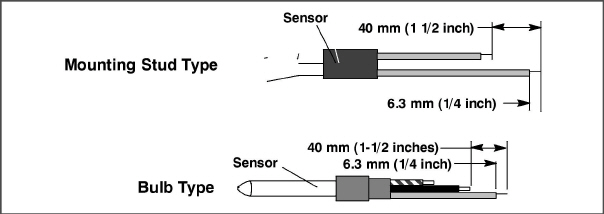
d.Prepare the cables by cutting wires to the opposite of the sensor (See Figure 7.27).
When installing a single wire color two wire sensor, cut one wire of existing two wire cable 40mm (1-1/2 inch) shorter than the other wire.
When replacing two single sensors with a combination (3-wire) sensor, the black wires of the cables should be cut to the same length and the red wire of one cable cut to the shorter length.
When replacing a original 3-wire sensor, cut the black wire to the middle length and the red wire to the shorter length.
e.Strip back insulation on all wiring 6.3mm (1/4 inch).
f.Slide a large piece of heat shrink tubing over the cable, and place small pieces of heat shrink tubing, one over each wire, before adding crimp fittings as shown in Figure 7.27.
g.If required, slide the cap and grommet assembly onto the replacement sensor. If the replacement sensor is of a larger diameter than the original, a different grommet may be required.
h.Slip crimp fittings over dressed wires (keeping wire colors together). Make sure wires are pushed into crimp fittings as far as possible and crimp with crimping tool.
i.Solder spliced wires with a 60% tin and 40% lead Rosincore solder.
j.Slide heat shrink tubing over splice so that ends of tubing cover both ends of crimp as shown in Figure 7.27.
k.Heat tubing to shrink over splice. Make sure all seams are sealed tightly against the wiring to prevent moisture seepage.
l.Slide large heat shrink tubing over both splices and shrink.
Do not allow moisture to enter wire splice area as this may affect sensor resistance.
m.Reinstall sensor, refer to Section 7.24.3.
The P5 Pre-Trip test must be run to inactivate probe alarms (refer to Section 5.9).
Figure 7.27 Sensor and Cable Splice

a. Sensors STS/SRS
To properly position a supply sensor, the sensor must be fully inserted into the probe holder. This positioning will give the sensor the optimum amount of exposure to the supply air stream, and will allow the Controller to operate correctly. Insufficient probe insertion into the probe holder will result in poor temperature control due to the lack of air flow over the sensor.
It is also necessary to ensure that the probe tip does not contact the evaporator back panel. The design minimum clearance of 6mm (1/4 inch) should be maintained (see Figure 7.28).
b. Sensor RTS/RRS
Reinstall the return sensor as shown in Figure 7.29. For proper placement of the return sensor, be sure to position the seal section of the sensor against the side of the mounting clamp.
c. Sensor DTS
The DTS sensor must have insulating material placed completely over the sensor to insure the coil metal temperature is sensed.
Figure 7.28 Supply Sensor Positioning
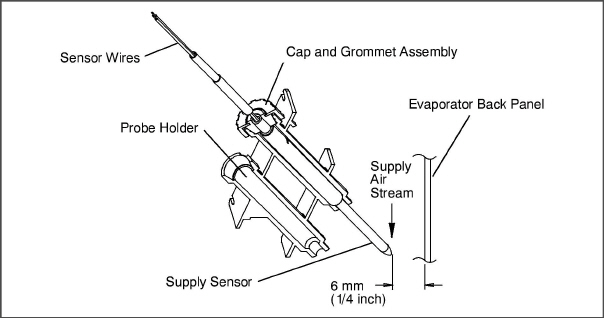
Figure 7.29 Return Sensor Positioning

7.25Vent Position Sensor (VPS)
The vent position sensor (VPS) determines the position of the fresh air vent in near real-time via the Cd45.
The fresh air VPS alarm (AL50) will occur if the sensor reading is not stable for five minutes or if the sensor is outside of its valid range (shorted or open). This can occur if the vent is loose or the panel is defective. To confirm a defective panel, assure that the wing nut is secure and then power cycle the unit.
The alarm should immediately go inactive. Check the four-minute stability requirement. If the alarm reoccurs after the four minutes and the panel was known to have been stable, then the panel should be replaced.
If the alarm immediately reappears as active, the panel should be replaced.
Upper VPS:
In order to replace the VPS, the panel must be removed and replaced with another upper fresh air panel equipped with VPS.
Upon installation, a new VPS assembly requires calibration as follows:
1.Rotate the vent to the 0CMH/CFM position.
2.Code select Cd45 will automatically be displayed. Press the Enter key and hold for five seconds.
3.After the enter key has been pressed, the display will read CAL (for calibration).
4.Press the ALT MODE key and hold for five seconds.
5.After the calibration has been completed, Cd45 will display 0 CMH/CFM.
Lower VPS:
1.Remove Condenser fan guard.
2.If unit is equipped with Partlow recorder, remove four Partlow box assembly mounting bolts and pull Partlow box assembly away from unit.
If unit is not equipped with Partlow remove left hand access panel to obtain clearance behind fresh air make-up assembly.
3.Remove the two nuts and two washers that hold the slide assembly on. These threads are staked the nuts will be cutting threads during removal.
4.Remove slide assembly.
5.The VPS bracket may be riveted in place. If that’s the case, drill out rivet heads. If bracket is bolted, remove bolts, washers, and nuts.
6.Note position of wire ties and wire routing for new sensor installation.
7.Remove sensor and bracket assembly from the backside of fresh air make-up.
8.Insert new sensor assembly through clearance hole where the old sensor was removed and route wire harness as noted in step 7.
9.Mount bracket to unit using bolts, washers, and nuts.
10.Wire tie wire harness in locations noted in step 7.
11.Calibrate sensor:
a.Use a multi-meter set to 200k ohms. Connect lead to VPS connector.
b.Turn the gear wheel on the motor all the way to the right (clockwise) until it stops.
c.Adjust the gear wheel counter clockwise until the meter reads 6.5k ohms (approximately).
d.Install the VPS slide door so that the door is flush against the bottom rail, the motor gear and the door teeth are meshed, and the gear wheel does not move from the set position
12.Position slide assembly back on to studs and reinstall two washers and two nuts that secure slide assembly.
13.Stake the ends of the two studs on panel assembly with wire cutters so that nuts will not be easily removed.
14.Reinstall Partlow box assembly if equipped, or access panel.
15.Reinstall condenser fan guard.
7.26.1Servicing the eAutoFresh Air Filter
Removing the Air Sample Filter Element
The air sample filter element can be accessed in two ways:
1.Through the eAutoFresh side evaporator access panel (see Figure 3.2).
2.Through the inside of the container by lowering the upper evaporator panel.
a.By hand, unscrew and remove the filter cup from the bottom of the air sample filter assembly.
b.Remove the filter element from the filter assembly.
c.Install the new air sample filter element by reversing the above steps.
7.26.2Checking eAutoFresh Drive System
Checking the Auto Slide:
a.To check with an ohmmeter, disconnect the four pin connector to the stepper motor. With a reliable digital ohmmeter, check the winding resistance. In normal ambient, the motor should have 72 to 84 ohms measured on the red/green (a−b terminals) and on the white/black (c−d terminals) leads. If an infinite or zero reading occurs, check connections or replace the motor. If near normal or normal reading occurs, proceed to Checking the Controller.
b.To check with a SMA−12 portable stepper drive tester. The SMA−12 portable stepper drive tester (Carrier Transicold P/N 07−00375−00) is a battery operated stepper drive which will open and close the auto slide, which allows a more thorough check of the motor.
Checking the Slide Motor:
a.Turn unit OFF.
b.Disconnect the four pin connector from the Stepper Drive to the Stepper Motor, (see Figure 7.23).
c.Attach the SMA−12 portable stepper drive tester to the Stepper Motor.
Figure 7.30 Stepper Components
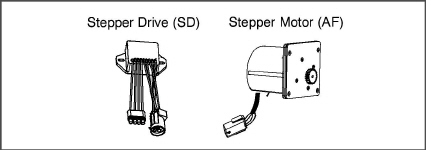
d.Set the SMA−12 pulse per second (PPS) to one PPS and press button to open or close the valve. Each LED should light sequentially until all four are lit. If an LED fails to light, it indicates an open on that leg caused by a poor connection or an open coil. Repair or replace as required to achieve proper operation.
e.Set the SMA−12 step rate to 200 PPS. Press open or close while watching the slide mechanism for movement, this is an indication that the motor is working.
f.If the slide moves using the SMA−12, but fails to move when connected in the unit (refer to “Checking the Drive Module” in the section that follows.)
Checking the Drive Module:
a.Turn unit OFF.
b.Disconnect the four pin connector to the Stepper Motor.
c.With a voltmeter set to read 24 volts AC, attach the positive lead to the drive module outlet pin A (wire 1A) of the four pin connector and the negative lead to the B pin (wire 1B).
d.Turn ON unit, and watch the volt meter. After a short delay, the reading should rise to approximately 12 volts.
e.Repeat for pins C and D (wires 2A and 2B).
f.If only one set of pins reads a voltage, check connections and retest.
g.If the retest reads out the same, the drive module or controller is faulty.
h.If no voltage is present in any step, the output from the controller to the drive module may be faulty. Check the connections and wires from the controller to the drive module.
i.To replace the drive module, disconnect all connectors, unscrew from mounting, and replace with a NEW drive module in reverse order.
Checking the Controller:
a.Turn the unit OFF.
b.Disconnect the six pin connector to the stepper drive from the controller.
c.With a voltmeter set to read 50 volts DC, attach the positive lead to outlet pin A of the six pin connector, and the negative lead to pin B or TP−9 of the controller.
d.Turn ON the unit for 40 seconds, and watch the voltmeter. There should be approximately 24 to 32 VDC shown on pin A.
e.There should be zero volts on pin B.
f.After a short delay, the reading should rise to approximately 24 to 32 VDC on pin E.
g.Pins C and D will have zero to 5 volts transistor logic (TTL) signals present, however, this can only be checked with the connector assembled as this is an open collector type circuit.
Checking the outputs on A, B and E will verify that the controller is supplying power to the drive module. To be thorough, and if it is desired, the signals on pins C and D can be checked as follows:
h.Install a jumper assembly (Carrier part number 07−00408−00) to connect the drive module and controller connectors as shown in Figure 7.31.
i.Connect the positive lead of the voltmeter to test connector socket C and negative lead to socket B, and run as before by resetting unit.
j.Repeat for sockets D and B.
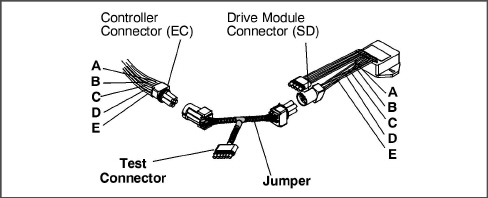
There should be approximately five volts DC on sockets “C” and “D” (S1 and S2) when measured as above. If not the connections or controller is faulty. If any of these pins are not consistent, the connections or the controller is suspect. Check and replace as required.
7.26.3Servicing the eAutoFresh Drive System
To replace the Drive Motor Assembly:
a.Remove the bolts that secure the eAutoFresh Panel (3, Figure 7.32) to the front of the unit. Reach in, cut tie wrap, (2) and disconnect the motor connector (1). Bring panel to work area.
b.Remove four screws (8) fastening the grille (7).
c.Remove six screws (9) fastening the rails (5 and 11), the slide plate (10) and the gasket plate (6). Set components aside for reassembly.
d.Remove the four screws (12) fastening the motor cup (4) to the panel. Cut sealer on outside and inside of motor cup assembly. Push out the motor cup assembly from the rear of the panel.
e.Mount the replacement motor cup assembly in the panel using original screws. Torque screws to 0.29 mkg (25 +/− 1 Inch pounds).
f.Reapply sealer to the inside and the outside of the motor cup assembly.
g.Mount the upper & lower rails, slide plate and gasket plate using original hardware. Apply thread sealant and torque screws to 0.29 mkg (25 +/− 1 Inch pounds).
h.Mount grille assembly using original hardware. Apply thread sealant and torque screws to 0.29 mkg (25 +/− 1 Inch pounds).
i.Reconnect the motor connector.
j.Replace the bolts that secure the eAutoFresh Panel to the front of the unit.
k.Carry out functional test. Refer to Section 5.4.3 step c.
Figure 7.32 Motor Cup Replacement
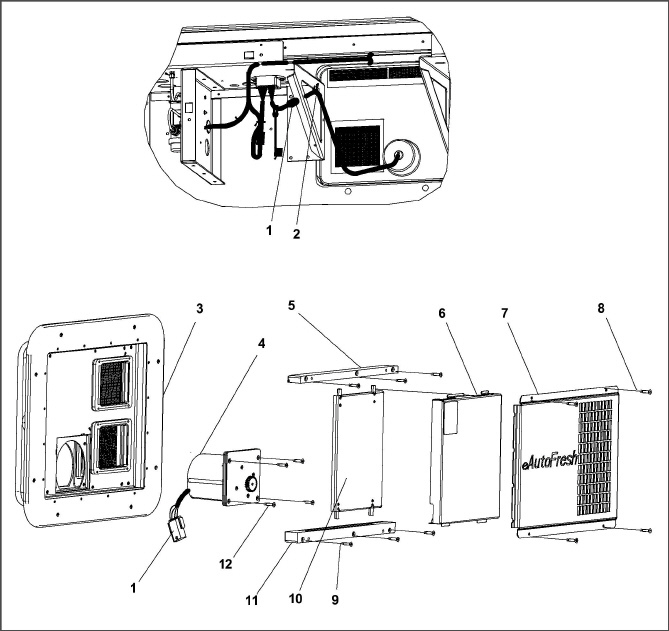
- - - - -
7.27Electronic PARTLOW Temperature Recorder
The microprocessor based temperature recorder is designed to interface with the DataCORDER to log temperature with time. The electronic recorder will automatically record the return air, supply air, or both, based on the setting of temperature controller configuration code CnF37, refer to Table 4–4. The recorder reads and records data from the Controller in present time, under normal operating conditions.
If using the Electronic Partlow Recorder CTD P/N 12-00464-xx Where xx= an odd number (example: 12-00464-03)
The recorder will STOP when the power is OFF, and the pen tip will remain at the last recorded temperature on the chart. When power is applied, and the power off period is less than thirty days; the pen tip will move to 25°C (77°F), the chart will advance to present time, and the pen tip will move to the currently recorded temperature.
If the power has been OFF for more than thirty days, the recorder will NOT re-synchronize (the chart will not advance to present time), the pen tip will move to the currently recorded temperature, and the recorder will resume normal temperature recording.
If using the Electronic Partlow Recorder CTD P/N 12-00464-xx where xx= an even number (example: 12-00464-06)
The recorder will STOP when the power is OFF, and the pen tip will remain at the last recorded temperature on the chart. When power is applied and the power off period is less than thirty days, the recorder will retrieve the logged data from the DataCORDER for the power off period and record it onto the chart. Thereafter, the recorder will resume normal temperature recording.
If the optional DataCORDER battery pack is being used and the charge is too low to enable recording during the power off period of less than thirty days, the pen tip will move to below the inner chart ring for the period when NO data was recorded by the DataCORDER.
If the power has been OFF for more than thirty days, the recorder will NOT re-synchronize (the chart will not advance to present time), the pen tip will move to the currently recorded temperature, and the recorder will resume normal temperature recording.
a.Turn power to the unit OFF.
b.Open the recorder door (see Table 7.33, item 1).
c.Locate the connector below the recorder, and squeeze the ears together to disconnect the plug (item 6).
d.Remove the four mounting screws (item 8) and remove the recorder.
e.Install the new recorder by reversing the above steps.
To prevent recorder corrosion, it is important to assure the door is securely closed at all times after completing the chart change.
a.Lift the stylus (item 5, Table 7.33) by grasping the arm near the base, and pulling the arm away from the chart until it snaps into its retracted position.
b.Remove the chart retaining nut (item 10), remove the used chart, and record today’s date on the old chart.
c.Press the “Change Chart” button (item 2).
Failure to press the change chart button when changing a chart with the power OFF may result in the chart advancing when power is applied.
d.Install a new chart. Make sure the chart center hole is placed over the center hub and the chart edges are behind the four hold down tabs (item 9).
e.Mark today’s date, container number, and other required information on the new chart and install under hold down tabs.
f.Replace the chart nut loosely. Rotate the chart until the correct day is aligned with the “start arrow” and hand tighten the chart nut.
g.Gently lower the stylus arm until the pen tip (item 4) comes in contact with the chart.
Do not allow the recorder stylus to snapback down. The stylus arm base is spring loaded, and damage may occur to the chart, or the stylus force may be altered.
DO NOT move the stylus arm up and down on the chart face. This will result in damage to the stylus motor gear.
Figure 7.33 Electronic Partlow Temperature Recorder
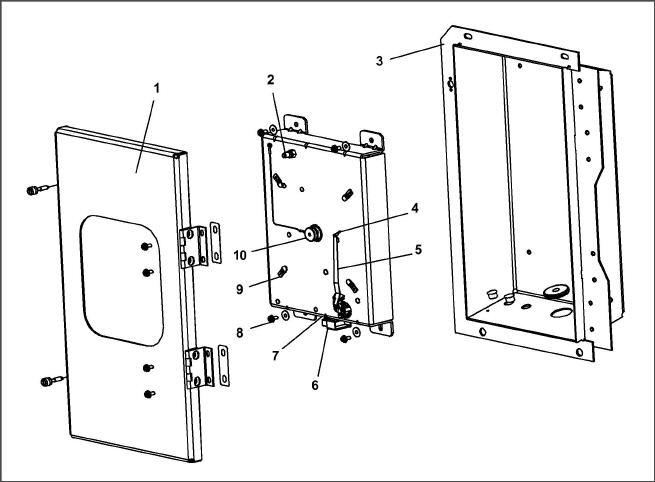
7.Calibration Button (Located underneath)
8.Mounting Screws, #10-24 x 7/16 inches long
- - - - -
7.27.3Adjusting the Recorder Stylus
Proper stylus force upon the chart paper is important. Factory adjustment is 113 to 127 grams (4 to 4.5 ounces). To measure the force, use a spring type gauge and attach it under the stylus as close as possible to the pen tip (Figure 7.33 item 4). Exert pull on the gauge perpendicular to the chart surface. The measured force should be noted just as the pen tip leaves the surface.
The two coil springs near the base of the stylus are NOT involved in establishing chart contact force. They serve only to hold the stylus in its retracted position.
Correct adjustment is made by carefully bending the portion of the stylus arm between the bend near the pen tip and the first bend towards the stylus arm base. If the force is too low, the stylus trace will be light and difficult to read. If the force is too great, wrinkling or tearing of the paper chart may occur.
7.27.4Re-zeroing the Recording Thermometer
For Electronic Partlow Recorder CTD P/N 12-00464-xx
Where xx= an even number (example: 12-00464-06)
Use chart CTD P/N 09-00128-00 (°F) P/N 09-00128-01 (°C).
a.Press the “Calibration” button (item 7, Figure 7.33) on the bottom of the recorder. The pen tip will drive fully down scale, then move upscale to the chart ring at 0°C (32°F), and stop.
b.If the tip of the pen (item 4) is on the 0°C (32F) chart ring the recorder is in calibration, proceed to step c. If the tip of the pen is NOT on the 0°C (32°F) chart ring, the operator must loosen the two screws on the bottom of the stylus arm to adjust the pen tip manually to the 0°C (32°F) chart ring. Tighten the screws when adjustment is complete.
c.Press the calibration button and the pen will position itself to the correct temperature reading.
7.27.5Re-zeroing the Recording Thermometer
For Electronic Partlow Recorder CTD P/N 12-00464-xx
Where xx= an odd number (example: 12-00464-03)
Use chart CTD P/N 09-00128-00 (°F) P/N 09-00128-01 (°C).
a.Press the “Calibration” button (item 7, Figure 7.33) on the bottom of the recorder. The pen tip will drive fully down scale, then move upscale to the chart ring at -29°C (-20°F), and stop.
b.If the tip of the pen (item 4) is on the -29°C (-20°F) chart ring the recorder is in calibration, proceed to step c. If the tip of the pen is NOT on the -29°C (-20°F) chart ring, the operator must loosen the two screws on the bottom of the stylus arm to adjust the pen tip manually to the -29°C (-20°F) chart ring. Tighten the screws when adjustment is complete.
c.Press the calibration button and the pen will position itself to the correct temperature reading.
7.28Maintenance of Painted Surfaces
The refrigeration unit is protected by a special paint system against the corrosive atmosphere in which it normally operates. However, should the paint system be damaged, the base metal can corrode. In order to protect the refrigeration unit from the highly corrosive sea atmosphere or if the protective paint system is scratched or damaged, clean area to bare metal using a wire brush, emery paper, or equivalent cleaning method. Immediately following cleaning, spray or brush on zinc-rich primer. After the primer has dried, spray or brush on finish coat of paint to match original unit color.
7.29Composite Control Box Repairs
This procedure provides instructions for repair of the Carrier Transicold composite control box. Damage to the control box may be in the form of a chip or hole, a crack, a damaged thread insert or damage to the door hinge inserts. Generally, the object of the repair must be to ensure sufficient strength is restored to the damaged area and the repair must keep the box water tight. Information on repair kits and repair procedures for each type of damage is provided in the following paragraphs. Ambient temperature must be above 7°C, (45°F) for proper curing of epoxy repairs.
Cracks in the control box are repaired using a fiberglass patch over the damaged area. Materials required are included in the Fiberglass Patch Kit supplied with Crack Repair Kit, Carrier Transicold part number 76-00724-00SV (see Table 7–3).
a.The surface must be clean and dry. Roughen the surface with sandpaper to ensure a good bond.
b.Cut the fiberglass cloth to allow a 25mm (1 inch) overlap around the area to be repaired.
c.Stretch and position the cloth over the area to be repaired and secure it with masking tape.
d.Make up sufficient epoxy glue to cover the cloth by mixing equal parts of resin and hardener. Saturate the cloth with the epoxy glue, spreading evenly. 6-31 T-318
e.Remove the tape and overlap the edge of the cloth approximately 6 to 12mm (1/4” to 1/2”) with glue.
f.Epoxy will dry in 45-60 minutes. When completely cured (12 hours), use sandpaper to smooth edges of the patch.
Chips and holes in the control box are repaired using a piece of aluminum or stainless steel to cover the damaged area. The material can be cut to suit and riveted in place. An adhesive sealant must be used to make the repair watertight. The adhesive sealant (Sikaflex 221) is included in Crack Repair Kit Carrier Transicold part number 76-00724-00SV (see Table 7–3). Do not use an acetone based silicone sealant, which can be identified by a vinegar-like odor.
a.To make up the patch, cut a piece of aluminum or stainless steel so that it will overlap the damaged area by at least 40mm (1-1/2”) on all sides.
b.Choose rivet locations and drill the rivet holes in the corresponding locations on the control box and patch piece.
c.Apply the adhesive sealant around the damaged area to form a seal between the control box and the patch piece.
d.Rivet the patch piece in place.
e.File smooth any rough edges (including rivets) that may come into contact with wires.
The threaded brass inserts that are molded into the control box will need to be replaced if the threads become stripped or if the insert becomes loose. The inserts and epoxy are contained in repair kit, Carrier Transicold part number 76-50084-00 (see Table 7–4). There are 6 different inserts used in the control box. Refer to Figure 6-35 for the locations of the various inserts.
An epoxy application gun is also needed, Carrier Transicold part number 07-00391-00.
The damaged insert must be removed from the control box. Table 7–5 identifies the drill size and drill depth to be used for each insert. A stop ring should be used on the drill bit to limit the depth.
a.Center the drill bit on the insert and drill to the prescribed depth.
b.Remove the chips from the drilled hole.
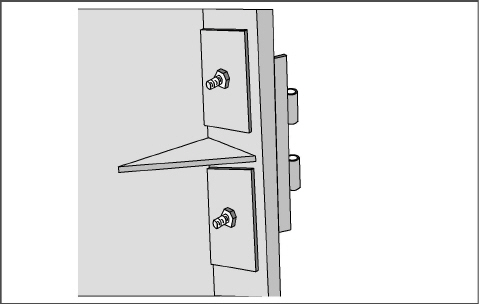
c.Mix the two component epoxy and fill the hole halfway to the top with epoxy.
d.Press the insert in until it is flush with the surface.
e.Wipe away any excess epoxy. The part is ready for service after the bond material has hardened and is tack free (approximately 20 minutes).
If the door hinges have been pulled from the control box, drill and reinstall the hinge as shown in Table 7.34 and described in the following steps:
Materials needed:
1.Cut two square pieces of 3mm thick (1/8 inch) aluminum or stainless steel approximately 40mm (1 5/8”) square. These squares will serve as backing plates.
2.Two nuts, bolts (10-24 x 1”) and washers for each insert that needs repair.
a.Drill a 1/4” hole in the center of each square backing plate.
b.Pass the bolts through the bolts holes in the door hinge, then through the control box at the location where the hinge insert pulled out.
c.From inside the control box, slide the backing plates over the bolts and secure in place with the washers and nuts.
Item |
Description |
Part Number |
Qty |
|---|---|---|---|
1 |
Insert Repair Kit - Includes |
76-50084-00 |
1 |
2 |
. . . Insert - 17.53 x 9.91mm (.690 x .390in) 1/4-20 Threads |
34-06231-01 |
10 |
3 |
. . . Insert - 15.88 x 6.35mm (.625 x .250in) 10-24 Threads |
34-06231-03 |
10 |
4 |
. . . Insert - 25.15 x 7.54mm (.990 x .297in) 10-24 Threads |
34-06231-04 |
10 |
5 |
. . . Insert - 10.16 x 9.53mm (.400 x .375in) 10-24 Threads |
34-06231-05 |
10 |
6 |
. . . Insert - 12.7 x 9.91mm (.5 x .390in) 1/4-20 Threads |
34-06231-06 |
10 |
7 |
. . . Insert - 9.53 x 6.76mm (.375 x .266in) 10-24 Threads |
34-06231-07 |
10 |
8 |
. . . Durabond Epoxy E20-HP (Loctite 29314) |
02-00082-00 |
1 |
9 |
. . . Static Mixing Tube (Loctite 983440) |
07-00390-00 |
1 |
10 |
. . . Instruction Sheet |
98-02338-00 |
1 |
Insert repair procedures require use of an Application Gun, Carrier part number 07-00391-00 (Loctite 983435).
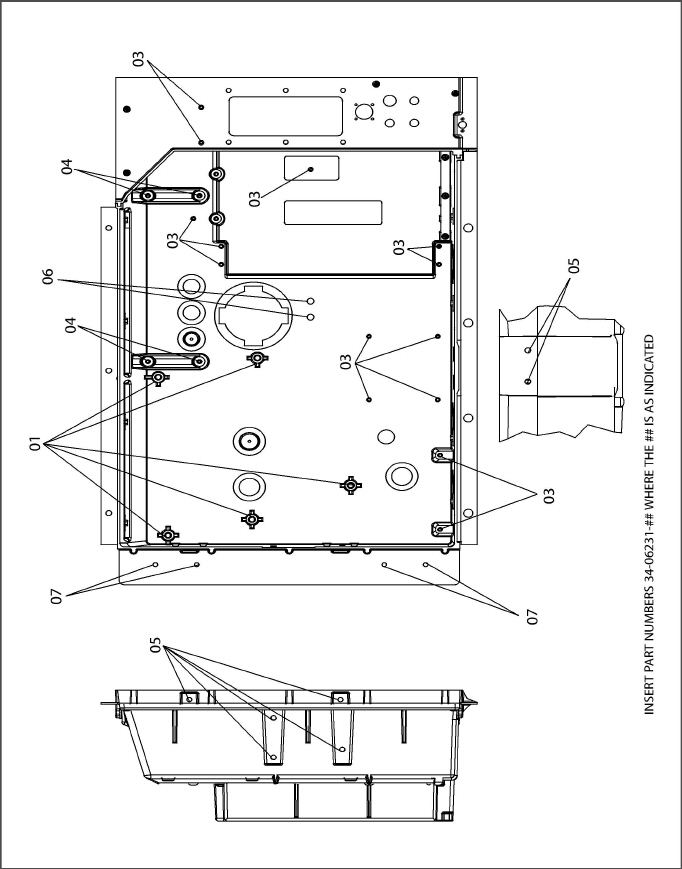
7.30Communications Interface Module Installation
Figure 7.36 Communications Interface Installation
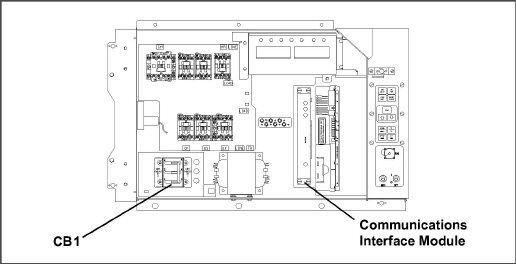
Units with communication interface module provision have the required wiring installed. The provision wiring kit (part number 76-00685-00), includes three pre-addressed wires installed between the circuit breaker and communication interface module locations. These wires are to be connected to the module and circuit breaker to allow the module to communicate over the power system. To install the module, do the following:
The unit power plug must be disconnected to remove power from circuit breaker CB1
a.CB1 is connected to the power system, see wiring schematic. Ensure that the unit power is off AND that the unit power plug is disconnected.
b.Open control box, see Figure 7.36 and remove low voltage shield. Open high voltage shield.
c.Remove the circuit breaker panel, with circuit breaker, from the control box.
d.Locate wires CB21/CIA3, CB22/CIA5 and CB23/CIA7 that have been tied back in the wire harness. Remove the protective heat shrink from the ends of the wires.
e.Attach the three wires as addressed to the LOAD side of the circuit breaker.
f.Refit the circuit breaker panel.
g.Fit the new RMU into the unit.
h.Remove plugs CIA, CIB and CID from the wiring harness and attach to the module.
i.Replace the low voltage shield.
7.31Power Factor Corrector Capacitors (PFC)
The power factor corrector capacitors are of the permanent-split capacitor type. There are a total of three capacitors with discharge resistors enclosed in a single case.
a. When to check for a defective capacitor
The capacitors assist in correcting current draw by the compressor. If one or more of the capacitors is faulty, there will be an imbalance in current. In addition, the power consumption of the unit will increase.
b. Removing the capacitor
Make sure power to the unit is OFF and power plug disconnected before removing capacitor(s).
Before removing the capacitors the terminals must be checked for voltage with a multimeter. The discharge resistors installed on the unit (capacitors) should bring the voltage to a safe level in a minute. However, there may be a broken resistor that retains voltage for a longer period, it is highly recommended to wait 15 minutes and to check for voltage.
If the capacitors require discharging, first, turn the unit power OFF and disconnect the unit power plug. Then, place a 20,000 ohm, 2 watt resistor across the terminals of the capacitor for approximately 30 seconds.
•If container is empty - Open upper rear panel of the unit. The capacitors will be on the right and may be serviced after checking discharge.
•If container is full - Remove the upper fresh air makeup vent.
c. Checking the capacitor
If the capacitor is suspected of malfunction, you may choose to simply replace it. Direct replacement requires a capacitor of the same value. Two methods for checking capacitor function are:
1. Volt-ohmmeter set on RX 10,000 ohms:
Connect ohmmeter leads across the capacitor terminals and observe the meter needle. If the capacitor is good, the needle will make a rapid swing toward zero resistance and then gradually swing back toward a very high resistance reading. The reading should read about 330,000 ohms (for a good capacitor) due to the discharge resistors.
If the capacitor has failed open, the ohmmeter needle will not move when the meter probes touch the terminals. If the capacitor is shorted, the needle will swing to zero resistance position and stay there.
2. Capacitor analyzer:
The function of the analyzer is to read the microfarad value of a capacitor and to detect insulation breakdown under load conditions. The important advantages of an analyzer are its ability to locate capacitors that have failed to hold their microfarad ratings, or those that are breaking down internally during operation. It is also useful in identifying capacitors when their microfarad rating marks have become unreadable.
Table 7–6 Recommended Bolt Torque Values (Dry, Non-Lubricated for 18-8 Stainless Steel)
Bolt Diameter |
Threads |
in-lb |
ft-lb |
N-m |
|---|---|---|---|---|
Free Spinning |
||||
#4 |
40 |
5.2 |
0.4 |
0.6 |
#6 |
32 |
9.6 |
0.8 |
1.1 |
#8 |
32 |
20 |
1.7 |
2.3 |
#10 |
24 |
23 |
1.9 |
2.6 |
1/4 |
20 |
75 |
6.3 |
8.5 |
5/16 |
18 |
132 |
11 |
14.9 |
3/8 |
16 |
240 |
20 |
27.1 |
7/16 |
14 |
372 |
31 |
42 |
1/2 |
13 |
516 |
43 |
58.3 |
9/16 |
12 |
684 |
57 |
77.3 |
5/8 |
11 |
1104 |
92 |
124.7 |
3/4 |
10 |
1488 |
124 |
168.1 |
Non Free Spinning (Locknuts etc.) |
||||
1/4 |
20 |
82.5 |
6.9 |
9.3 |
5/16 |
18 |
145.2 |
12.1 |
16.4 |
3/8 |
16 |
264 |
22.0 |
29.8 |
7/16 |
14 |
409.2 |
34.1 |
46.2 |
1/2 |
13 |
567.6 |
47.3 |
64.1 |
9/16 |
12 |
752.4 |
62.7 |
85 |
5/8 |
11 |
1214.4 |
101.2 |
137.2 |
3/4 |
10 |
1636.8 |
136.4 |
184.9 |
Table 7–8 Compressor Torque Values
Size Diameter (inches) |
Threads Per Inch |
Torque Range |
Usage |
|
|---|---|---|---|---|
ft-lb |
N.m |
|||
1/16 |
27 (pipe) |
8 - 12 |
11 - 16 |
Pipe Plug - Crankshaft |
1/8 |
20 (pipe) |
6 - 10 |
8 - 13 |
Oil Return Check Valve − Crankcase |
1/4 |
20 (pipe) |
20 - 25 |
27 - 34 |
Pipe Plug − Gauge Connection |
1/4 |
20 |
10 - 12 |
13 - 16 |
Connecting Rod cap screw |
1/4 |
28 |
12 - 15 |
16 - 20 |
Baffle Plate - Crankcase |
12 - 16 |
16 - 22 |
Side Shield |
||
6 - 10 |
8 - 13 |
Oil Pump Drive Segment |
||
12 − 16 |
16 − 22 |
Unloader Valve |
||
5/16 |
18 |
16 - 20 |
2 - 27 |
Cover Plate − Plate End |
Bearing Head |
||||
Terminal Block Cap Screws |
||||
20 - 30 |
27 - 41 |
Suction Valve |
||
Discharge Valve |
||||
3/8 |
16 |
40 - 50 |
55 - 70 |
Pump End Bearing Head |
Bottom Plate − Crankcase Compressor Foot |
||||
Cylinder Head |
||||
7/16 |
14 |
55 - 60 |
76 - 83 |
Motor End Cover − Crankcase |
5/8 |
11 |
25 - 30 |
34 - 41 |
Crankshaft |
5/8 |
18 |
60 - 75 |
83 - 103 |
Oil Bypass Plug − Crankcase |
#10 |
32 |
4 - 6 |
5 - 8 |
Oil Pump Drive Segment |
1-1/2 |
18 NEF |
35 - 45 |
48 - 62 |
Oil Level Sight Glass |
NEF − National Extra Fine |
||||
Figure 7.37 R-134a Compressor Pressure and Motor Current Curves Vs. Ambient Temperature, Sheet 1
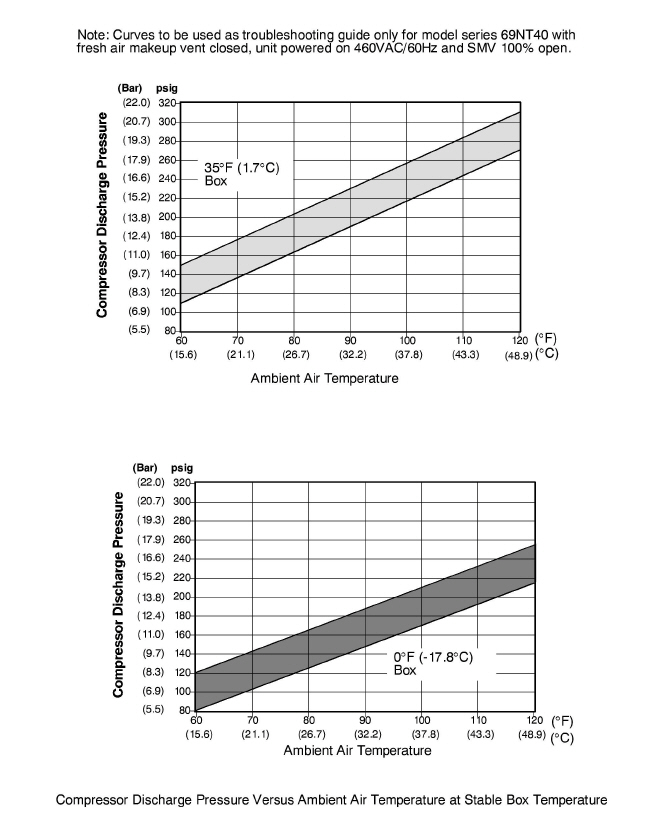
Figure 7.38 R-134a Compressor Pressure and Motor Current Curves Vs. Ambient Temperature, Sheet 2
